QUFA and Ontario workers union take Ford government to court
Asbah Ahmad Senior News Editor
Queen’s University Faculty Association (QUFA) is joining the Ontario Federation of Labour and other unions across Ontario in a lawsuit against the Government of Ontario.
The statement of claim, filed on July 25, highlighted the union’s concerns surrounding the Ontario government’s passage of Bill 124.
The Bill was passed into provincial law on Nov. 8, 2019, the same year as the passage of the Student Choice Initiative.
Bill 124 regulated wage increases in public sector employment, like the health care industry, teaching, and public universities, such as Queen’s. The central claim QUFA and unions across Ontario are making is Bill 124 violates the right to meaningful processes of collective bargaining and the right to strike in accordance with The Charter.
All claims made by the unions remain untested in a court of law.
In the legal filing, the unions brought up concerns around the general impact Bill 124 has on collective bargaining.
The unions argue the one percent cap on wages and compensation are unilateral and arbitrary in nature—having an intermediate and negative impact on the ability of unions to negotiate settlements that are “free and fair.”
The unions argue the primary issue with the wage cap is the fact unions are forced to negotiate below the one per cent cap.
“While Bill 124 affects the ability of both unions and management to freely bargain, it has a more significant impact on unions as it shifts the balance of bargaining power in favour of management, leaving unions with almost no leverage,” the statement of claim said.
Combined with issues of bargaining, the suit claims the Government of Ontario is invalidating freely negotiated agreements and arbitrated awards.
The Treasury Board Secretariat (TBS) ordered Montfort Renaissance—an organization supporting addictions treatment, senior care, mental health and housing—to renegotiate the terms of its agreement after the passage of Bill 124, despite the original collective agreement being in effect from 2017-22.
The lawsuit lays out the challenges employees face when it comes to recruitment and retention, combined with increasing inflation rates. Low-income workers and racialized individuals were explicitly mentioned as being the most impacted from the effects of Bill 124.
In a statement to The Journal, Maher Abdurahman, media spokesperson at the Ministry of the Attorney General, declined to comment on behalf of the government.
“As this matter is before the courts, it would be inappropriate to comment,” Abdurahman said.


Jordan Morelli, QUFA president, told The Journal in an interview that Bill 124 is a large issue on campus.

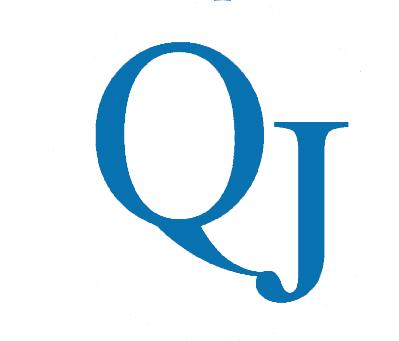
“I’m outraged that the Government of Ontario would intervene in such a way that it’s such a violation of everybody’s rights to belong in a union and bargain, collectively,” Morelli said.
Morelli expressed his concerns around the treatment
of racialized workers and minorities across the workplace.
“Kingston’s not the most diverse city. It’s getting better, but you know, there’s not many restaurants or grocery locations where you can get food items that are traditional to your cultural backgrounds.”
Another issue not directly tied to Bill 124 is Queen’s reliance on term adjunct professors. Morelli believes these staff are in a position where exploitation of their work is easier due to the contractual nature of their work.
Concerns of contract academic staff were brought up in the lawsuit, which claimed “precarious academic workforce” are undercompensated for their work.
Morelli said this plays into concerns around retention of academics and employees on campus. This could be further exacerbated by the impacts of a loss of collective bargaining.
According to Morelli, Ontario’s per capita funding of post-secondary education is the lowest in Canada, which contributes to the increased burden placed on adjunct professors.
“[Queen’s] is precluded from bargaining at a higher amount than one per cent. It might well be in their interest to bargain in the climate of seven per cent inflation, to offer increases,”
Morelli said.
Morelli believes if Queen’s offered higher salary increases,
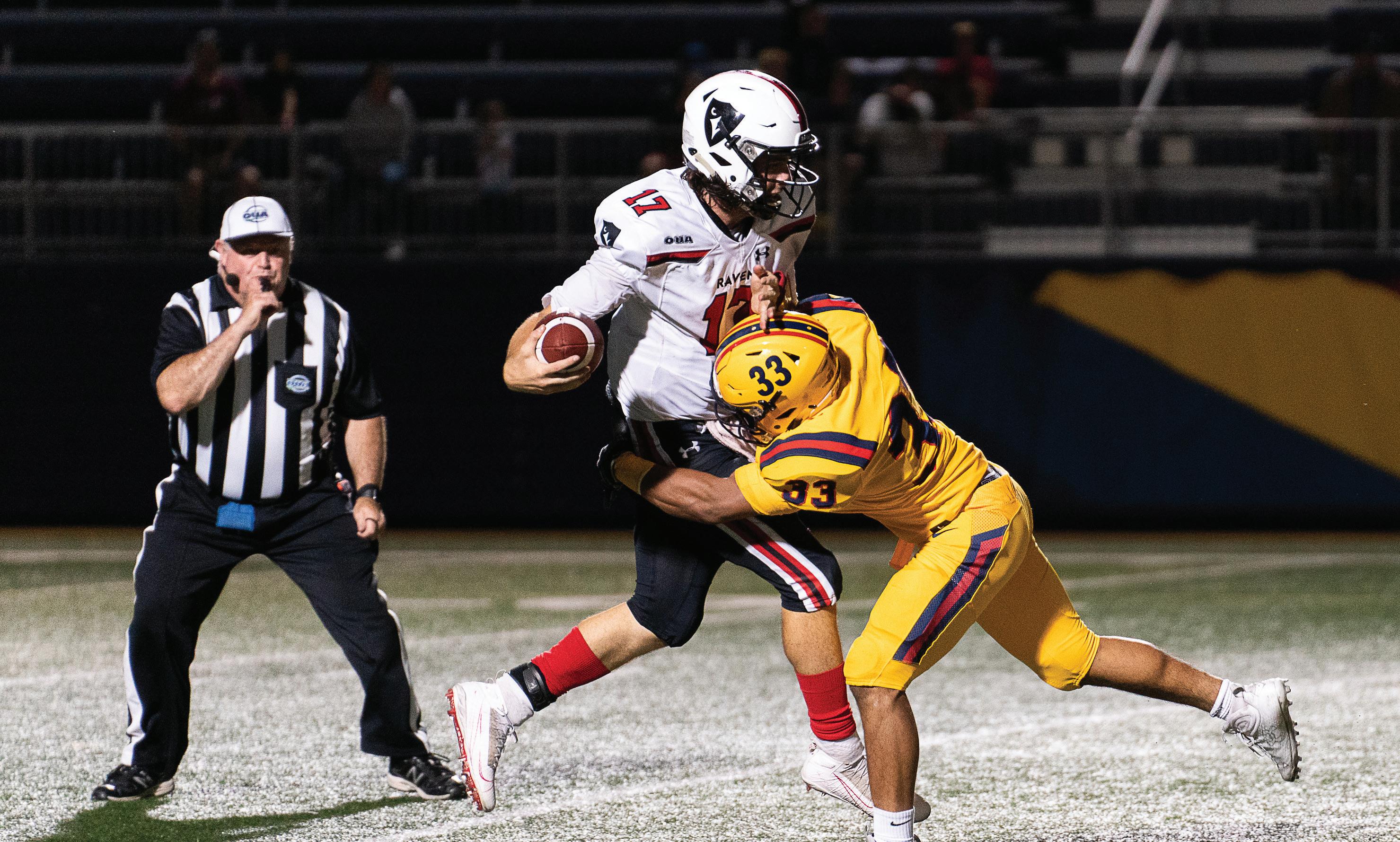
there would be increased retention across faculties.
In speaking to students and student leaders directly, Morelli emphasized the importance of the legal action being undertaken by QUFA and other unions.
“This impacts student’s collective power—you have the AMS, ASUS, SGPS, and PSAC 901. The Ford government tried to destroy student unions as well when he first got elected. All of his union busting actions are completely unconstitutional,” Morelli said.
The University recognizes employees are central to Queen’s position as a leading post-secondary institution in Canada.
“Term adjuncts can acquire rights, such as a right to teach the same course on a recurring basis, or the right to be employed continuously,” the University said in a statement to The Journal


The University said Bill 124 has a moderating effect on compensation at Queen’s.
“Since the Act came into force, all bargaining agents on campus that have concluded bargaining with the university have entered into renewal agreements that comply with the Act.”
“We cannot speculate on the outcome of the legal challenge to the Act that is currently before the courts. We continue to monitor the impact of the Act on hiring and retention.”
PHOTO BY CURTIS HEINZL
Winners from the photo contest
Posthumous releases and life after death
No one scores against Queen’s rugby
Making your student house a home
Sterling Seunarine sacks Ravens quarterback Tanner DeJong during the fourth quarter.
Q ueen ’ s u niversity — v ol . 150, i ssue 7 — F riday , s eptember 23, 2022 — s ince 1873 queensjournal.ca @queensjournal @queensjournal @queensjournal@thequeensjournal Situated on the traditional lands of the Anishinaabe and Haudenosaunee peoples.the journal ‘Exactly what we needed’: Football wins big at home See Sports on pg 11 Bees at Queen’s page 2 page 8 page 10 page 12 page 14
Asbah Ahmad Senior News Editor
The next time you’re near Richardson Stadium, you might notice a buzz of activity.
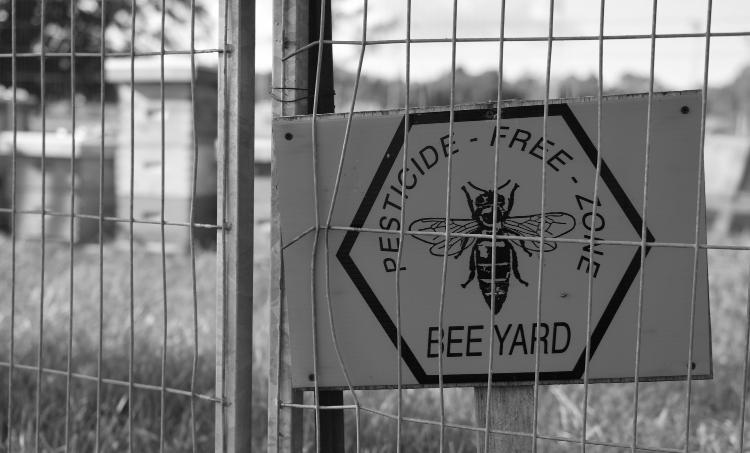
The 240,000-bee apiary is part of a two year long pilot project run in a joint partnership between Aramark—the University’s food provider—and Queen’s Hospitality Services.
The idea behind starting the apiary originated from the Queen’s Sustainability Working Group. Hospitality Services’ Theresa Couto, registered dietitian and sustainability manager, said the unit is always looking for innovative and new ways to be sustainable.
“The benefits to an apiary are
inarguable—repopulating an endangered insect, providing a source of sustainable local food production, and contributing to plant and animal diversity,” Couto said in an interview with The Journal.
The Housing and Ancillary Services sustainability framework closely aligns with the United Nations Sustainable Development Goals 2, 11, 12, and 15. These goals range from zero hunger to responsible consumption and production.
Couto went over the rationale behind choosing the West Campus location and the use of the honey harvested on campus.
“With West Campus, we are still benefiting our campus ecosystem [...] The hives are situated near the
community gardens. So with that, there’s an opportunity for the bees to pollinate, there’s a water source there—so it’s a great location.”
“It’s a great opportunity to bring that sustainability and wellness focus to those living in the West end of campus.”
With the 480 pounds of honey harvested so far, the apiary is being integrated back into the Queen’s community for use.
“The plan is for 50 per cent of the harvest to be used in our campus recipes that would be in residence dining, fresh to go products, the Bake Shop, as well as events, catering, and the Donald Gordon Hotel and Conference Centre,” Couto said.
“Then the remainder of the
Back on track: Terry Fox run returns to Queen’s
Queen’s Terry Fox run raises $3,175 for cancer research
Sophia Coppolino Senior News Editor
Despite a rainy forecast, 50 runners showed their support for cancer research by running a lakeside route on Sept 18.
The route was the scene of the 2022 Queen’s Terry Fox run, which is run each year by the Engineering Society (EngSoc) at Queen’s. Returning in-person for the first time since 2019, the event raised $3,175 for cancer research.
“[We raised] a lot more than we expected,” Liz Uchida, co-coordinator of the event said in an interview with The Journal. “With students it’s a lot harder to fundraise money because people have so much less to give.”
The event brought together Queen’s students, professors, and Kingston community members. Not all 90 runners who registered online showed up ready to run, but Uchida and co-coordinator Graeden Lau welcomed several last-minute runners.
The race started and ended at Clark Hall, running through City Park and across Breakwater Park. Runners could participate in the three-or five-kilometre route.
“Even with the weather, everyone who showed up was super into it,” Lau said.
“We were talking to one person who ran it the last time it was in-person and he said it was the most running opposed to walking he has ever seen,” Uchida added.
Uchida became involved with the Terry Fox run because one of her best friends survived osteosarcoma—the same type of cancer Terry Fox had.
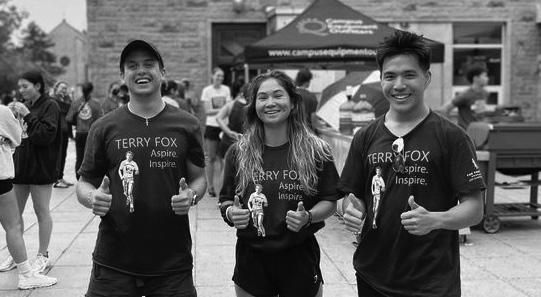
While COVID-19 itself didn’t pose many hurdles, with two years of Terry Fox runs moved online, all the knowledge on how to run the event was lost.
Days before the run, Lau and Uchida found themselves having to move the entire route from the road to the sidewalk after the city denied their parade permit.
“We had volunteers make sure that everyone followed the traffic laws,” Lau said.
Uchida and Lau hope other faculties will become more involved in the event in the future.
“It was fun,” Lau said. “I was honoured to organize something like this and to support the cause.”
Apiary makes its way to Queen’s
Bees produce 480 pounds of honey
honey is available for sale at several retail locations.”
Dan Foster, the registered beekeeper who works at the apiary, described his work and the meaning behind working with bees in a statement to The Journal.
“Bee farming is both rewarding and at times frustrating. Working with honey bees is a way for me to connect with nature,” Foster said. “When I am in an apiary I feel calm and focused on what is going on inside the hive. Beekeeping is a form of mental health therapy.”
Foster said his work benefits local farmers in the area, since bees provide the valuable ability to pollinate farms.
“The frustrating part of bee farming is trying to manage all the negative environmental impacts that affect a colony. There are several factors that impact the health of a colony,” he said.
The primary concerns Foster has come from the loss of plant and bee diversity, combined with a reduction in habitat and forage.
Compounded with large amounts of toxins in the environment, the bee population is facing challenges.
Foster highlights beekeeping’s importance to a wide range of sustainable industries, such as candle making, wax making, and, in some cases, healing medicines. These often depart from the traditional conception of honey as just a source of food.
Along with the apiary pilot project, Couto said Hospitality Services is working to implement sustainability initiatives across the board.
“It goes beyond just environmental sustainability. We have our Peach Market, which opened Sept. 12, and that’s a partnership between the AMS and student affairs. Then a lot more focus this year on our good to go reusable container initiative in order to reduce the volume of single use waste.”
A check-up on campus food establishments
Health unit inspected various campus food establishments in Sept.
Asbah Ahmad Senior News Editor
Multiple Queen’s dining and retail facilities were inspected by health and safety inspectors in early September. The results were mixed, with some non-critical and critical violations being listed.
At Ban Righ Dining Hall, an inspection took place on Sept. 7. The only non-critical observation was on the use of handwashing stations for employees. Employees are expected to use designated handwashing stations only for employees. Documentation noted this observation was corrected.
On the same day, Leonard Dining Hall was inspected where the non-critical observation of failure to maintain handwashing stations was documented.
On Sept. 16, inspectors checked out Wally’s. Here, inspectors documented two non-critical observations: failure to maintain handwashing stations and failure to ensure equipment surfaces were cleaned as necessary.
The handwashing observation was corrected during inspection. The critical violation at Wally’s was for temperature control of potentially hazardous food. This violation was corrected during inspection. The current standard according to regulators is 4° Celsius, or lower, or 60° Celsius, or higher.
Location 21 and the Biosciences Complex Tim Horton’s were not cited for any violations.
In a statement to The Journal, the University said they take health and safety seriously, and work closely with the health unit to ensure all of their locations follow safe food handling. “All Aramark food services staff
undergo mandatory and extensive food safety training before working in our establishments and supervisors hold food safety certifications that must be renewed annually to uphold best practices,” the University said.
“Additional measures include utilizing tracking systems that monitor food temperatures, conducting random quality audits, and implementing safety precautions for food allergens across our campus food locations.”
Queen’s added they’re proud of the quality and high standards in place at their dining facilities.
For student-run establishments, Clark Hall Pub, Grad Club, and Common Ground Cafe (CoGro) were both inspected this September.
Clark Hall Pub was cited for three critical violations, and one non-critical violation on Sept. 16. The critical violations included failure to maintain handwashing stations—which are maintained and kept adequately supplied.
Similar to Wally’s, Clark Hall Pub was documented for internal temperature of foods. The final critical violation was failure to ensure the food handler washes hands as necessary to prevent contamination.
All three critical observations were ordered to be corrected immediately. The non-critical violation was corrected during inspection with the violation being in regard to mechanical equipment not maintained to provide sufficient chemical solution rinse.
At CoGro, the Sept. 14 violation was listed as food equipment not being in good repair. CoGro was given until Sept. 21 to correct this violation.
For the Grad Club, three noncritical violations, one repeat violation, and one critical violation was observed. This included shelf design for cleanliness, equipment surface cleaning, and a critical handwashing station violation.
The apiary fence is located near Richardson Stadium.
SUPPLIED BY QUEEN’S UNIVERSITY
SUPPLIED BY TERRY FOX RUN AT QUEEN’S
News2 • queeNsjourNal ca Friday, 23 september, 2022
People came to run despite the rain.
NEWS
Politics professor says ‘experiential learning isn’t just a description
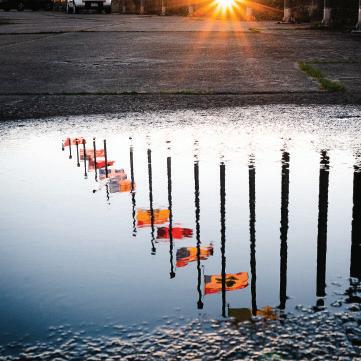 Skylar Soroka Assistant News Editor
Skylar Soroka Assistant News Editor
Professor Stephen Larin sat down with The Journal to discuss Queen’s brand-new internship opportunity that will run as a Political Studies course.
Larin became the faculty coordinator of the internship program this May, with internships beginning in the 2023 winter semester. The program will act as a course titled POLS 598, which students receive credits for on a pass or fail basis.
“It was decided collectively
among the department that it was something we wanted to do and something our students have expressed interest in,” Larin said.
“My job over the past few months is to figure out what the program would look like in specific details and recruit the partners.”
Larin confirmed 22 official partners and 36 placements among those partners, with some partners offering more than one placement. For instance, the City of Kingston has seven different placements, each one in a different department.
There are approximately ten additional partners that plan to participate in future iterations of the program, Larin added.
“We’re limiting the program to 20 students in the winter term this year as a kind of trial-run, but it is intended to be a permanent part of our curriculum.”
The department plans to increase the number of students who are allocated positions in subsequent years, both in the fall and winter terms, if there’s high demand. Larin said the department is working to ensure the opportunity is known to students.
“The undergraduate administrative assistant distributed the announcement to all political studies students via email. I asked my colleagues to think about any students they think will be a good fit for one of the partners.”
Larin’s goal is for everyone in the department to know about the opportunity within the next week.
“The placements available are very diverse. There is purely political work (City Hall and Kingston Hall) and there is also a range of non-governmental
Political Studies department develops internship opportunity
organizations (Loving Spoonful, Rotary Club, among others) so the type of opportunities will depend on the type of organization.”
The only criteria to apply for the course is to be in third or fourth year, be a Political Studies major, Political Studies joint-honours student, or in the Political Studies stream of the PPE program, and have a minimum of 3.3 GPA across all Politics courses.
“Once we choose our twenty students, they undergo a random lottery system. The person in first place gets their first preference of internship, and so on,” Larin said.
“Immediately after the allocation to partners is done, I will contact the students who have been granted their placement and then they contact the partner to talk about the workplace, do a police check.”
Larin said the threshold for applying is relatively high and students who are successful in their application should be good students who are highly competent and have good communication skills.
If a student isn’t a good fit for the organization, they will be reallocated to a different organization on their preference list.
According to Larin, the internship course will start with an orientation and then move into
it’s low commitment. Providing the opportunity for new connections and friendships in a low-stress environment.
Events students should look out for this year are Con-Ed Camp, Workshop Week, Relay for Life, and the Back to School Social.
class meetings, weekly reflections, a presentation, and a final report based on the students’ experiences.
One of the most crucial aspects of this internship is the professional relationships developed.
“Social capital is the resources available to you due to the relationships you have—this opens up opportunities,” Larin said. “Building those professional relationships is one of the most important things when it comes to these organizations.”
Larin added the Political Studies department is trying to break the cycle of needing experience to get experience which, according to him, is an opportunity barrier.
“Experiential learning isn’t just a description—it also includes reflection on how that experience relates to your studies, theories, and broad conceptualizations that are part of those studies.”
Larin added the program is collaborative across disciplines.
“I just signed an agreement with a team of five talented fourth-year Computing and Information Science students who will design and create an internship management system for us as their final-year project in CISC 498.”
about how Con-Ed students can get involved with CESA—CESA council is currently hiring for positions open to all years, with various levels of time commitment.
Skylar Soroka Assistant News Editor
Queen’s Concurrent Education Student Association (CESA) hosted a charity pancake breakfast on Sept. 18 to raise funds for Women for Women, a non-for-profit organization supporting women in Afghanistan.
From 10 a.m. to 12 p.m., around 30 students came to Johnson Street to receive a pancake breakfast and donate whatever they could to support the cause.
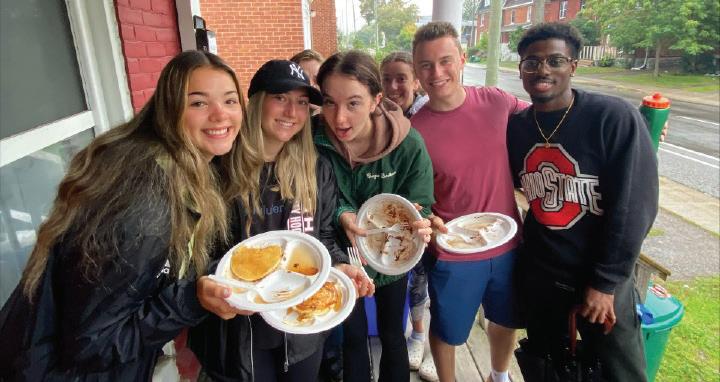
The fundraiser raised over $200 for the charity and was open to all students to attend.
CESA Vice-President (External) Avery Desrosiers, Event Director Kayla Emmerton, and Community Affairs Coordinator Paige Gascho spoke to The Journal about the event.
Gascho said the funds will go towards supporting women through “the power of education.”
“I found this charity to be fitting for a Con-Ed event, considering
all of the students in this program are passionate about providing accessible education to all […] it aims to create sustainable programs in Afghanistan and to aid those who are currently evacuating the dangerous conditions.”
“I want to use my role through CESA to help these women and families in any way I possibly can, and to hopefully spread awareness and spark this same drive within other students.”
According to Desrosiers, the event is a Con-Ed tradition, occurring annually to raise money for charity and connect Con-Ed students with the Kingston community.
“We find that a pancake breakfast is a great event to start our year off as it’s an event that is low intensity for participants, easy for students to participate in, and of course, everyone loves pancakes.”
Desrosiers said CESA hosts roughly one to two similar
events each week because there’s no fixed timeframe and
“Specific to fundraising and charitable events, CESA and the Community Affairs team plan to host at least three more events where students can volunteer their time or donate towards charitable causes,” Desrosiers added.
Desrosiers also spoke
“If you’re looking for ways to get involved with a smaller time commitment, pay close attention to CESA’s social media platforms to hear about all of the fun events coming up,” Emmerton added.
journal_news@ams.queensu.ca
Professor Stephen Larin talked about the opportunities available to students.
PHOTO BY CURTIS HEINZL
All proceeds raised went to Women for Women, a non-profit organization. BY
NewsFriday, 23 september, 2022 queeNsjourNal ca • 3
CESA hosts annual charity pancake breakfast Vice-President (External) says ‘Con-Ed is all about tradition’
SUPPLIED
CESA
Aimée Look Assistant News Editor
Sustainability Professor in the Smith School of Business Steven Moore
wants Queen’s to be a moral and sustainable leader through their actions and investments.
Moore sat down with The Journal to discuss sustainability on campus. According to him, Queen’s should do more than the “absolute minimum possible” to divest investments in fossil fuels. He said the University took the “weakest possible steps,” after “years of pressure” in response to the divestment movement on campus, which was spearheaded by students.
“That just shows a lack of education and awareness on the part of the Queen’s administration,” Moore said. “[The University is] deadweight dragged along behind students who have a much better idea about what their future is going to be if we don’t get off fossil fuels.”
Moore said Queen’s should create more gardens on campus. He believes lawns are “ecological deserts” despite being important places to run and play.
The University piloted an Employee Community Garden in May, planting two large communal plots near Jeffery Hall. It’s a shared
Commerce professor unearths Queen’s sustainability
garden space open to all registered gardeners and will contribute to a “more sustainable and vibrant community,” according to a press release.
Moore models sustainability through his own lifestyle, living in an earth-sheltered house in Tamworth, facing the Salmon River.
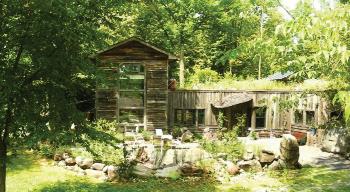
Earth-sheltered houses are built below or embedded in the ground. In Moore’s house, natural light seeps into each room from windows facing the south side of the house. The house naturally regulates its temperature, at around 12 to 16 degrees Celsius underground year-round.
“It’s nice and snug. Cool in the summer, and warm in the winter,” Moore said.
The house has many other sustainable features, including a “green roof” with wild-seeded grass, milkweed, and monarch butterflies; no lawn; and interior post and beam construction repurposed from a 1920 aircraft hanger from Uplands Airport in Ottawa.
The most sustainable house is the one that isn’t built, Moore said. In his Sustainability Strategies and Practices course at Queen’s, he teaches the most basic path to being more sustainable individually is to “reduce, repair, rent, refuse, reuse and repurpose” items.
Reducing demand looks like having smaller houses, fewer vehicles, and less stuff.
New Graduate Trustee pushes ‘action, advocacy and listening’
Tony Hu shares goals for the role
Aimée Look Assistant News Editor
Tony Hu, Meds ’26, has been appointed as Graduate Trustee as of 9 a.m. on Sept. 22. He ran for the position uncontested.
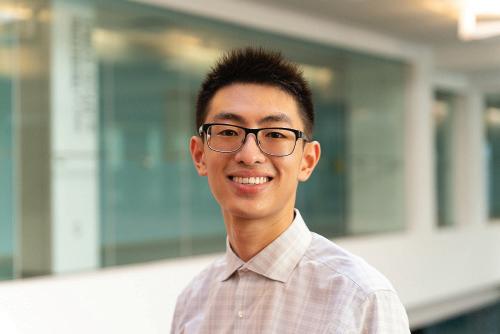
The Graduate Trustee is elected by SGPS students and serves a two-year term. Hu will represent graduate and professional students to the Queen’s Board of Trustees, attending their meetings. As one of only three students on the Board, Hu represents the interests and voices of students.
He won the election with 93 per cent affirmation from the 987 electors who voted.
“You get to engage with decision makers at the university to push forward some changes that would benefit students in the short and
long term,” Hu said in an interview with The Journal. “I think the real tangible effects of the role will be felt maybe many years down the line.”
Originally from Scarborough, Hu studied chemistry at U of T before coming to Queen’s.
Hu’s experience in governance comes from his time on the Arts and Science Council, Innis College Council, and U of T Library Student Advisory Committee.
Hu said he’s passionate about governance, adding it’s a chance to have dialogue with decisions makers and an effective outlet for creating change.
“[You are] directly expressing what you think and how you feel to people who are in positions where they’re able to enact changes.”
As the Graduate Student Trustee, one of Hu’s main focuses will be listening to the student community. Coming from U of T, Hu said he isn’t familiar with the environment at Queen’s.
“We have a $600 billion a year marketing machine globally that tries to convince us to buy stuff because our economy is based on buying stuff. Well, that simply will not work,” Moore said.
According to Moore, even if we found energy supplies to last hundreds of years, they wouldn’t be able to keep up.
“It is really a change in mindset. We won’t invent our way out of this. If we—humans—don’t change the way we view the world as something we can dispose of, then we will not survive.”
Moore started Repair Cafés in Stone Mills Township before the
pandemic, by gathering “handy people” who can show others how to repair things. The cafe idea started in Sweden and similar spots have sprung up all around the world, including in Kingston.
He believes starting a cafe would be of interest for students at Queen’s, especially because it’s fun and models the importance of repairing broken items.
According to Moore, demand and consumption are a large culprit in the climate crisis, and our society believes certain things to be essential. He said individual awareness is the first step, but action happens in groups.
“The idea is not to convince them first and then do something— the idea is to do something and then people will be convinced,” Moore said. “There are very smart people who have figured out how to mobilize large groups for a social good.”
Despite being critical sometimes, Moore is grateful for Queen’s.
“I’m thrilled to be back teaching in person. This is the best job in the world—talking to young people about ideas that really matter for their future. It’s just an absolute privilege to be able to do it.”
He’s looking to students to share their thoughts on issues at hand.
Climate action is very near and dear to Hu’s heart. He wants to propel the university to net zero goals to avoid a potential “climate catastrophe.”
Equity, diversity, inclusion, Indigeneity, and accessibility (EDIIA) were at the forefront of Hu’s campaign, as was student success.
He wants to understand university data and student
outcomes after graduation to understand how students can be better supported during their time at university—through mental health supports, career advising, or other non-academic supports.
Hu encouraged students to reach out to him via email with any communications they wish to bring to the Board, so he can fully represent the graduate student body.
“Not only am I expected to advocate for students, but I think
the other members of the Board are looking to me to provide that student experience.”
Over the next two years, Hu wants to represent the experiences and concerns of students.
“I really hope that I can get a lot of feedback from students that I can bring to the Board and its meaning, so I’m able to affect some really positive change here [at] Queen’s.”
Professor says ‘it’s important for students to know how the world works’
SUPPLIED BY STEVEN MOORE
Moore’s Earth-sheltered house lies facing the Salmon River in Tamworth.
The Graduate Trustee is one of three students on the Board of Trustees.
PHOTO BY CURTIS HEINZL
News4 • queeNsjourNal ca Friday, 23 september, 2022
Society ratifications kick off first AMS Assembly of the year
DSUS ratification and Orientation Week summit discussed at length
Aimée Look Assistant News Editor
AMS Assembly saw the Dan School Undergraduate Society (DSUS) remove its motion to be ratified as an undergraduate society on Sept. 22.
For the first time this year, the new 2022-23 AMS Assembly met in-person in Mitchell Hall to discuss a variety of matters. They planned an upcoming Orientation Week summit, the goal of which is to address concerns surrounding Orientation Week.

In total, Assembly passed 28 motions.
Society ratifications
The Dan School Undergraduate Society (DSUS) has been lobbying Assembly for two years to approve it as its own individual faculty society—separate from ASUS. According to the DSUS executive, Assembly must approve their request for ratification, which is then subject to referendum.
According to Noelle Sinkic, DSUS president, the organization has acted as a faculty society over the past few years, and it would be a disservice to students and the Assembly to not be re-ratified. Sinkic said they require the student fee to set them up for further financial success.
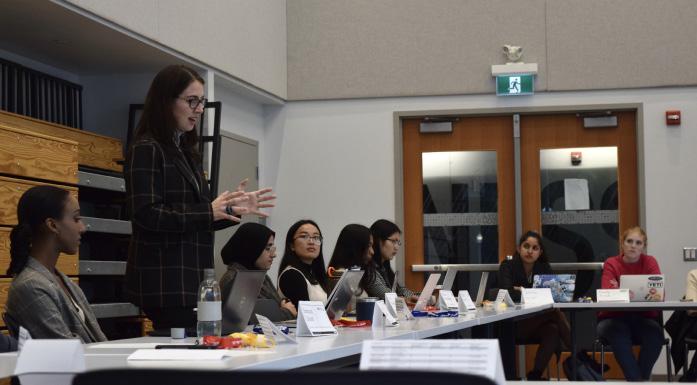
“As a faculty society, one of only two named schools in the entire University, DSUS deserves to have its students represented
to the highest legislative body of [undergraduate]students at Queen’s University,” Sinkic said at Assembly.
AMS President Eric Sikich brought to light issues of the membership size of DSUS, who don’t have enough students to qualify for representation in Assembly. DSUS encompasses less than 400 students while, based on the most recent Assembly policy, Assembly provides a society representative for every 500 students.
There was discussion between Sinkic and Sikich regarding the number of students counted under the Dan School. Students taking drama courses as medials don’t count, as they have voting rights through other AMS representatives, Sikich said.
Yara Hussein, ASUS president, said ratification of DSUS could set the precedence for 29 other student societies—namely, department student councils—to be ratified as faculty societies. Hussein’s concern was the over-amplification of student voices involved in multiple faculties.
“The relationships we have with student councils are [at] the heart of ASUS,” Hussein said.
Sinkic returned to the claim DSUS had already been unofficially ratified for two years and asked for an “exception to the rule,” saying they’ve already operated as a faculty society.
After the discussion branched to involve other ratified society presidents, DSUS removed the motion to be ratified as a faculty society.
Assembly passed a motion to ratify the Health Sciences Society as a new faculty society, subject to referendum.
ORT debrief summit
Assembly discussed holding a summit to discuss Orientationrelated concerns, as 2022 Orientation Week has wrapped up.
President of the Nursing Science Society (NSS) Crystal Sau and Computing Students’ Association (COMPSA) President Jagrit Rai both had grievances with Orientation Week operations.
Orientation Roundtable (ORT) leaders in the NSS required accommodations to have nursing clinical days moved to give them time to do adequate patient prep after Orientation Week. These accommodations were taken away four days before the start of Orientation, and students were expected to be present despite “suffering in terms of wellbeing,” Sau said.
Rai commented on issues with the accessibility of Orientation Week. He raised the motion to move the vote on next years’ ORT budget to the next Assembly. The motion was passed.
Callum Robertson, AMS vice-president (university affairs), thanked the society presidents for
addressing the issues. He noted the return of in-person Orientation Week was led by many leaders who had never experienced in-person Orientation themselves.
“It creates confusion, miscommunications, little things that can add up to big things—that shouldn’t be swept under the rug,” Robertson said.
He suggested society presidents send their grievances his way, to ensure they’re addressed at the summit.
President’s report
Sikich addressed the re-opening of the Student Life Center, which is currently running in “full force.”
The Rideau building, which provides housing to AMS clubs and services, will open before the end of September. The opening will provide more club spaces for students to book.
Vice-President (Operations) Report
All full-time Queen’s student transit fares will be covered by the AMS’s recently re-instated Bus-it program, according to AMS
Vice-President (Operations) Tina Hu.
Students can ride the bus for free on Kingston Transit by showing the driver the back of their student cards, which must be up to date by the end of September. Hu said part-time students can also opt-in to ancillary fees and receive this service.
According to Hu, the University is also reviewing its Sexual Violence policy, because it’s up for its triennial review next year.
Vice President of University Affairs Report
Chloë Umengan has been hired as the Internal Social Issues Commissioner (SIC) and hiring for a second SIC position—the External SIC—is still underway.
Robertson expressed his support for the new SIC.
“We’re really excited to have Umengan on the team. I think she brings a lot of great energy to the role.”
The first AMS Assembly of the year was held on Sept. 22.
PHOTO BY AIMÉE LOOK
PHOTO BY AIMÉE LOOK
Assembly voted on various motions.
NewsFriday, 23 september, 2022 queeNsjourNal ca • 5
For students living with disabilities, self-advocacy is key
Students and faculty members discuss living with disabilities on campus
Anne Fu Features Editor
When Madia McGowan, ArtSci ’24, arrived at Queen’s in 2020, she saw it as a “big adjustment”—but not in the way most students do. It’s not unusual for incoming students to see the shift to university as a turning point in their lives, but for McGowan, who was diagnosed with Crohn’s disease when she was 10 years old, that transition symbolized something more.
Away from home, McGowan had to learn how to monitor her chronic illness and adapt to living on her own for the first time. It was at Queen’s that she discovered ASUS Crohn’s and Colitis, a club that fundraises and spreads awareness about irritable bowel disease (IBD), typically led by those who live with the illness themselves. Beyond just advocating for students with chronic illness, the group serves as a wellspring of community and connection for other students on campus living with IBD.
Now in her final year at Queen’s, McGowan serves as president of the club, where she hopes to support other incoming students living with chronic bowel illnesses who were once in her position. Today, the club hosts discussions on navigating university life with an invisible disability, provides guidance on how to discuss IBD with friends and professors, and shares IBD-friendly recipes.
Such community groups represent a crucial form of empowerment for students with disabilities and chronic illnesses. According to McGowan, they allow peers to meet and support each other, discuss their experiences, and share strategies for navigating their disease.
“Crohn’s and Colitis is not only about fundraising and spreading awareness around IBD,” McGowan said in an interview with The Journal. “I also think that it’s where you build that community and you learn about accommodations, learn about different ways to live with the disease, or just have someone
to reassure you that whatever you’re going through, you’re not the only person.”
***
Nearly 3,500 students at Queen’s receive academic accommodations for a disability, and more than 50,000 such students are registered in accessibility offices around Ontario—but you might not be able to tell just from looking around a typical campus. In a world that wasn’t always designed with their experiences in mind, students with disabilities and chronic illnesses often find themselves coming up with their own ways to navigate the landscape of post-secondary education, forming communities of care and finding unique ways of speaking up for themselves.
For students like McGowan, those opportunities arise on both an individual and community level. Here at Queen’s, she organizes and advocates for other students with IBD through ASUS Crohn’s and Colitis.
On her own, McGowan finds managing her energy levels carefully is key to balancing her academics with her illness. This might look like following special diets, scheduling downtime in between sports and academics, using the University’s self-declared short term academic accommodation policy to give herself extra time when she needs it, or staying active to maintain her mental and physical health.
“My parents played a big role in supporting me, making sure that I eat well, and that I get enough sleep and not exercise,” McGowan said. “Coming to Kingston, I definitely had to make a couple adjustments to post-secondary. I hope Crohn’s and Colitis at Queen’s can build on those points and let other students know what to expect, and how to manage it.”
Caitlin Elrick, ArtSci ’25, sees a similar pattern in her own experiences. Elrick, who lives with rheumatoid arthritis, finds that every day is different for her. In order to account for the ups and downs of her illness, Elrick keeps herself highly organized with planners and weekly agendas.
“Some days, I wake up, and I’m exhausted, and I’m in a lot of pain, and I don’t want to do anything,” Elrick recounted to The Journal. “So I find I plan in advance a lot, because then if a day does come up, where I’m really not feeling good, it doesn’t like I doesn’t feel like my whole life is falling apart.”
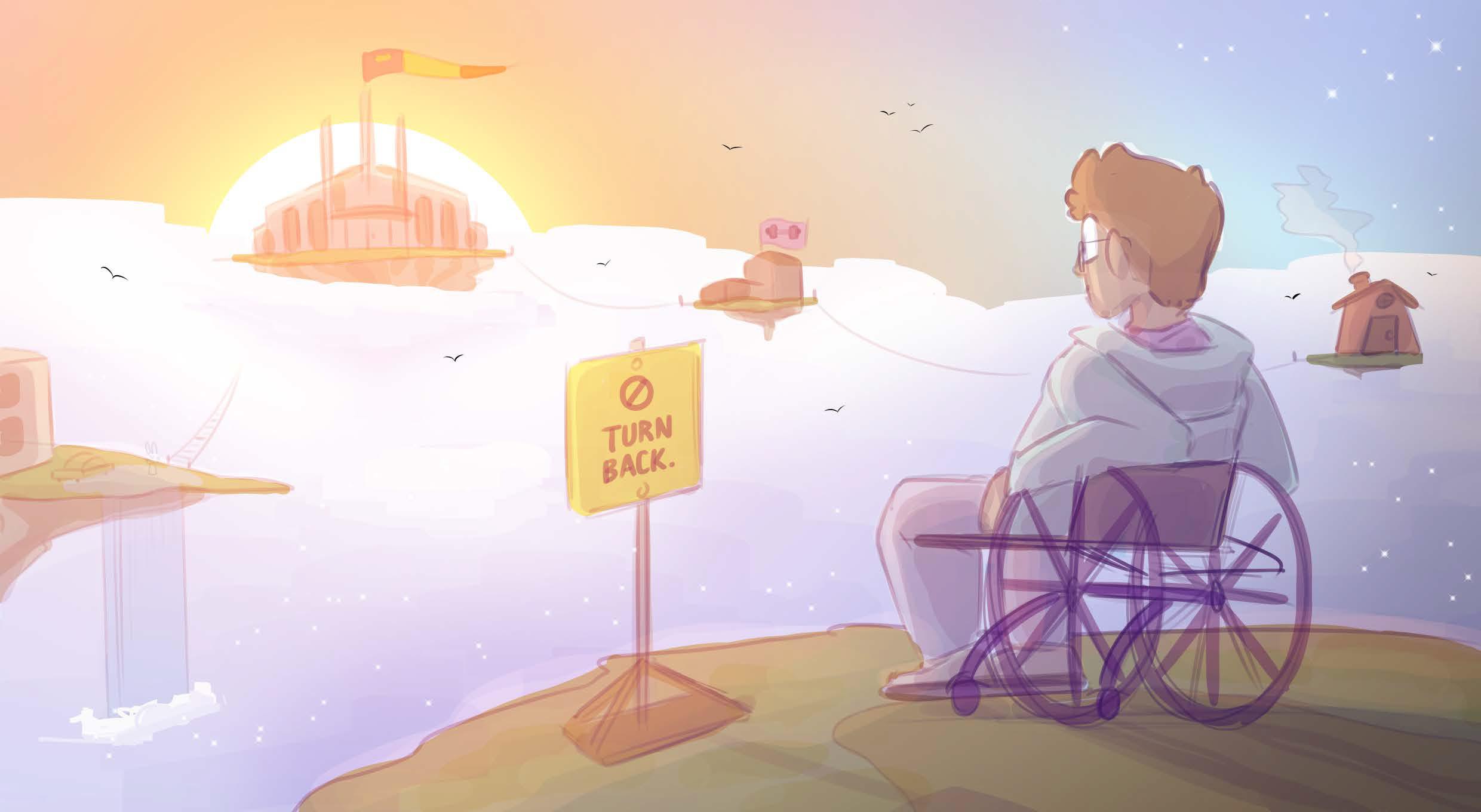
While both McGowan and Elrick have found ways to thrive at university,
they also see places where Queen’s falls short.
For McGowan, these gaps emerge in the lack of opportunities for multiple short-term accommodations a year. While she doesn’t need long periods of time off school, she’s had to use the self-declared short term academic consideration at least once a semester, and wishes there were ways for students like her to obtain more “sick days”—days when she has to manage her illness.
In Elrick’s case, there’s a lack of awareness and information around financial supports for students with disabilities. As a working student, Elrick says she didn’t know about the offerings the Student Awards Office and OSAP provides for students with disabilities until this summer.
Still, both students see their chronic illnesses as experiences that have shaped their identities to this day. McGowan considers the opportunity to build community with other students with IBD as vital evidence she belongs at Queen’s.
“I find it very reassuring when I have people in my community who have Crohn’s, and that’s a big reason why I’ve stepped into the role of co-chair [of ASUS Crohn’s and Colitis], because I want to continue to build that community,” she said.
As for Elrick, living with an invisible illness has given her greater empathy for others’ lives.
“It’s created part of my personality where I’m kind of very accepting of other people, and I always acknowledge that you don’t know what’s going on in everyone’s life. Because like I said, my [chronic illness] is an invisible illness, and you’d never necessarily think that I’m sick, but I am. That can go for anyone to see.”
Isaac Sahota, ArtSci ’22, once chaired Accessibility Queen’s (AQ), the AMS’ student-led advocacy group for students with disabilities. Now graduated, the former Queen’s student is studying law at UBC.
While at Queen’s, Sahota spent a significant amount of time advocating for students with disabilities. Although he’s proud of the community he formed and the initiatives he started—such as a mentorship program for students with disabilities, or the purchase of accessibility mats to make campus surfaces more accessible—he knows there are limits to this kind of advocacy.
Organizing wheelchair-accessible yoga or socials for students with disabilities with AQ is one thing, but tackling the structural accessibility issues present at Queen’s—like inaccessible sidewalks and roads—is another. Sahota, who uses a wheelchair, remembers how he had to navigate his first month at Queen’s without any accommodations, because of the time it took to set up an appointment with Queen’s Student Accessibility Services (QSAS).
Even afterwards, he recalls being unable to attend his lectures in Mackintosh-Corry when the accessible elevator was broken, or being faced with auditoriums that were completely inaccessible. Once the sidewalks filled up with snow during the winter, he sometimes found it impossible to get to class for weeks.
In these cases, Sahota contacted his professors and explain his situation. While he found that instructors were always eager to help, the process of asking for accommodations each time he missed a class or reporting an environment he found inaccessible was “exhausting.”
“When I’m doing the advocacy work, I’m happy I’m doing it, and I will keep doing it,” he told The Journal in an interview. “But what I’m trying to say is, at the end of the day, these are extra hours. You’re putting in this extra energy now apart from your regular life, apart from your regular academic stuff that you’re taking care of.”
To Sahota, gaps for students with disabilities remain commonplace, and the University still has a long way to go. Providing more bursaries and financial assistance for students with disabilities, asking about their needs earlier in the year so they arrive on campus with accommodations already in place, and ensuring a smoother transition from high school to university are key to easing the difficulties experienced by students with disabilities.
At UBC, Sahota says students with disabilities can use a shuttle to get from place to place—something he sees could be beneficial at Queen’s during the winter. According to him, the problem isn’t just that classrooms aren’t accessible, but that the ways students get to and from class also aren’t.
ILLUSTRATION BY PHLIP PRANAJAYA
Many students with disabilities struggle to transition from high school to university.
Features6 • queensjournal ca Friday, 23 september, 2022 FEATURES
***
Story continued online.
No federal holiday should celebrate colonialism
This past Monday, many Canadians were awarded a day off to mourn her majesty the Queen.
Prime Minister Justin Trudeau declared Sept. 19 a federal holiday, but let the provinces decide whether their people would observe it.
More than a few Ontarians were disappointed when Doug Ford decided against making Monday a holiday. While Ford likely didn’t make his decision based on disdain for the monarchy’s colonial past and present, it was nonetheless a good decision.
In the United Kingdom, food banks were closed and surgeries were postponed on Monday as the country mourned its official head of state. Many argued it was wrong to impose a day of mourning upon everyone considering how many UK residents have felt the effects of colonialism, particularly immigrants from former British colonies.
Considering our government claims to be focused on repairing relationships between settler Canadians and Indigenous peoples, the decision to make Monday a holiday in Canada has also been rightfully criticized for its hypocrisy.
On the topic of holidays, Ontario doesn’t have big plans for the National Day for Truth and Reconciliation either—a day designed for acknowledging and reflecting on Canada’s colonial identity. If we should observe any “day of mourning,” surely it should be that one.
If Canada seriously wants to move forward with reconciliation, declaring a federal holiday to mourn a Queen who represents colonial oppression is counterproductive.
Federal holidays are more than just days off. They come loaded with significance; what Canada chooses to recognize or commemorate with a holiday matters.
The Queen isn’t more deserving of the funeral pomp and circumstance than anyone else. It would make more sense to have a day of mourning for Wayne Gretzky or Celine
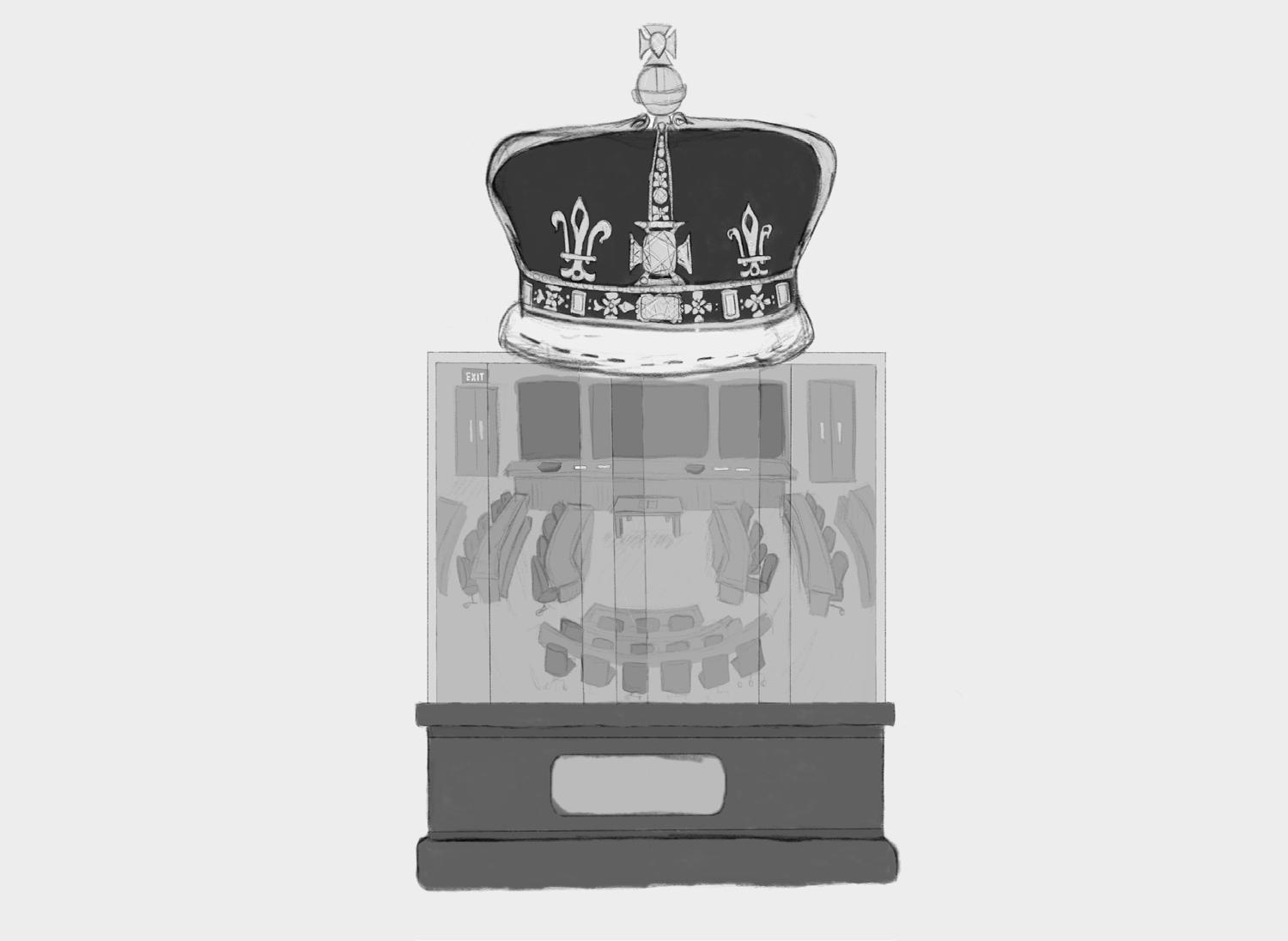
Dion when they die—both have made significant contributions to Canadian culture without symbolizing colonial oppression.
For most Canadians, the monarchy isn’t a significant part of their identity anymore.
Those who grew up with the Queen are mourning their youth and the world as they once knew it along with the woman herself. She represented consistency and stability that older people don’t see in any other institution.
This Monday felt like an inflection point in Canadian history and culture. The disconnect between how older and younger generations reacted to news of the Queen’s death shows how her pervasive glorification is breaking down as education and media evolve.
Within minutes of the news breaking, TikTok and Twitter flooded with memes and comedy sketches on the royal family.
ILLUSTRATION BY KATHARINE SUNG
While some of these videos and tweets were less than respectful, they point to a general disillusionment with the monarchy among Gen Z and Millennials.
Monarchy seems like such an outdated, even historic concept in 2022, especially when we’re used to frequent political turnover. New Canadian identities are emerging, and our priorities are changing in response.
No matter how you slice it, the monarch is a figurehead for the British colonial legacy. The Queen and her family held and still hold immeasurable institutional power and wealth gained by ravaging former colonies. We shouldn’t participate in the celebration of that legacy.
Canadians could use a holiday, but it shouldn’t be in the Queen’s name.
—Journal Editorial Board
Asking for help shows strength, not weakness
Mikayla Wilson Copy Editor
Many university students seem to believe that asking for help is a sign of weakness. However, recognizing when you need support and having the courage to seek it out is actually a sign of strength and academic engagement.
The idea that asking for help is somehow shameful is a misconception fostered by high-pressure educational environments. As students’ educational careers progress, pressures surrounding academic excellence become increasingly difficult to bear.
Do better. Enjoy learning. Understand everything. Get good grades. Don’t procrastinate. Be more efficient. Most importantly, above all else, don’t succumb to stress.
These pressures come from professors, parents, and even students themselves.
Competitiveness between students creates a toxic learning environment as it forces them to evaluate their success relative to their peers. This atmosphere leads students to believe they aren’t good enough by tying self-worth to an ability to outperform others instead of personal growth.
This way of thinking keeps students from asking for help. They fear it will make them a burden and show they’re incapable of independence—the ultimate failure.
Eventually, this fear of inadequacy paralyzes students and leaves them struggling silently. These emotions become all-consuming and manifest as academic burnout.
Even though we avoid asking for help to look intelligent, ironically, not asking results in poorer academic performance. It fosters a negative association with schoolwork that leaves students frustrated, exhausted, and unable to complete tasks.
Therefore, students who feel overwhelmed, whether it be related to their academics or personal life, should reach out for help.
Off-campus, students can reach out to loved ones who make them feel safe for emotional and moral support. For those
We shouldn’t be afraid to ask questions about assignments or class concepts; doing so improves understanding of the material and may help others in the class, too.
Queen’s also offers various academic and health services.
To find more information about these support systems, students can visit the Campus & Community Support Resources page on the Queen’s website. However, even though Queen’s has these resources available, many students don’t know they exist.
The University should focus on making it easy for students to access the help that’s available.
Brief classroom presentations about the various ways students can ask for help at the beginning of each semester might increase awareness of campus resources. That way, students are more likely to feel the institution cares about their wellbeing.
Although it may be nerve-racking, asking for help shows resilience—a trait that urtures success. So next time you feel overwhelmed, take a breath, evaluate your options, and seek support.
Volume @queensjournal
Editorial Board
Editor Ben Wrixon Julia Harmsworth
Production Dharmayu Desai Asbah Ahmad Sophia Coppolino Aimee Look Skylar Soroka
Features Anne Fu Suzy Leinster
Editorials Maia McCann
Editorials Katharine Sung
Opinions Sandrine Jacquot Rida Chaudhry Sam Goodale Sarah Maat
Lifestyle Maddie
Assistant Clanny Mugabe
Photo Curtis Heinzl
Assistant Herbert Mackenzie Loveys
Copy Vineeth Jarabana Cassandra Pao Mikayla Wilson
Graphics Amna Rafiq
BIPOC Ruth Osunde Alexis Ejeckam Sharon Sun
Contributing Staff
Contributors Sophia Ceccucci Aisha McIntyre
Staff Philip Pranajaya
Business Staff
Business Manager Chad Huang Sylvie Garabedian Eric Joosse
Fundraising Grace Moffat
Social Claire Schaffeler
Want to contribute?
For information visit: www.queensjournal.ca/contribute or email the Editor in Chief at journal_editors@ams.queensu.ca
Contributions from all members of the Queen’s and Kingston community are welcome. The Journal reserves the right to edit all submissions. The Queen’s Journal is an editorially autonomous newspaper published by the Alma Mater Society of Queen’s University, Kingston.
Situated on the traditional lands of the Anishinaabe and Haudenosaunee peoples. The Journal’s Editorial Board acknowledges the traditional territories our newspaper is situated on have allowed us to pursue our mandate. We recognize our responsibility to understand the truth of our history.
Editorial opinions expressed in The Journal are the sole responsibility of The Queen’s Journal Editorial Board, and are not necessarily those of the University, the AMS or their officers.
190 University Ave., Kingston, ON, K7L 3P4
Editorial Office: 613-533-2800
Business Office: 613-533-6711
Fax: 613-533-6728
Email: journal_editors@ams.queensu.ca
Please address complaints and grievances to the Editor in Chief and/or Managing Editor.
The Queen’s Journal is printed on a Goss Community press by Metroland Media in Toronto, Ontario.
Contents © 2021 by The Queen’s Journal; all rights reserved. No part of this publication may be reproduced without prior permission of The Journal.
seeking help outside their inner circle, the Government of Canada’s Mental Health page has various resources and hotlines that provide aids for specific situations.
On-campus, students can reach out to their TAs or professors about specific questions or concerns relating to a class.
Let’s remember asking for help is not a sign of weakness—being afraid to is.
Mikayla Wilson is a third-year Concurrent Education student and one of The Journal’s Copy Editors.
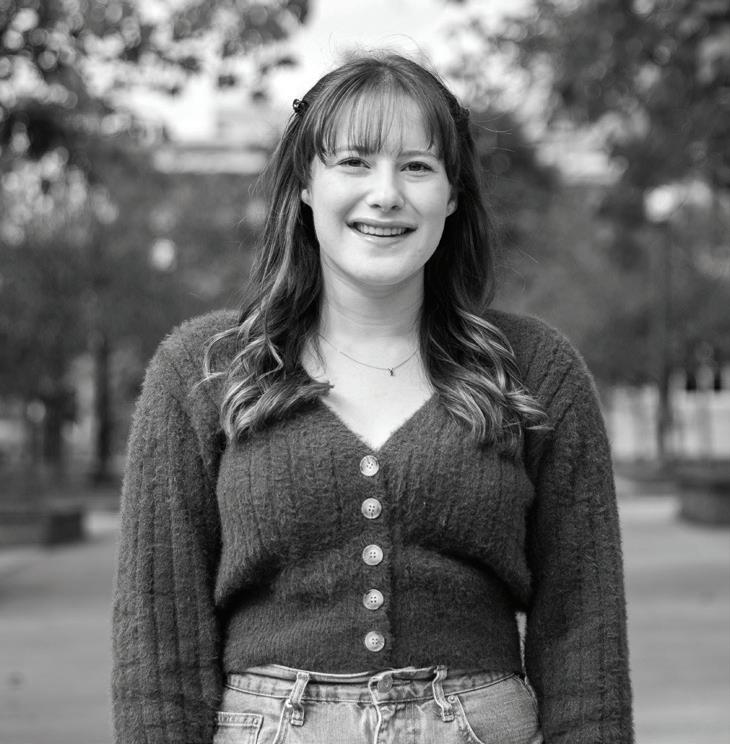 PHOTO BY HERBERT WANG
PHOTO BY HERBERT WANG
EDITORIALS The Journal’s Perspective EditorialsFriday, 23 September, 2022 queenSjournal ca • 7 THE QUEEN’S JOURNAL
150 Issue 3 www.queensjournal.ca
Publishing since 1873
in Chief
Managing Editor
Manager
News Editor
Assistant News Editors
Editors
Editor
Illustrator
Editor
Arts Editor
Assistant Arts Editor
Sports Editor
Editor
Hunt
Lifestyle Editor
Editor
Photo Editor
Wang Video Editor
Editors
Editor
Advisory Board Members
Illustrator
Sales Representatives
Representative
Media Coordinator
OPINIONS Your Perspective
Sexual violence should not be normalized at Queen's
or attempted against a person without the person’s consent, and includes sexual harassment, stalking, indecent exposure, voyeurism, and sexual exploitation.”
Sophia Ceccucci
Contributor
This article discusses sexual assault and may be triggering for some readers. The Kingston Sexual Assault Centre’s 24-hour crisis and support phone line can be reached at 613-544-6424 / 1-800-544-6424.
Queen’s is known for its academic achievements, notable alumni, and incredible faculty. However, it's also known for its notorious party scene.
Students see parties as a necessary outlet for their pent-up frustrations and to let loose with friends. However, we lose the perceived innocence of getting together for a couple of drinks when we examine the alarming statistics concerning sexual violence at Queen’s.
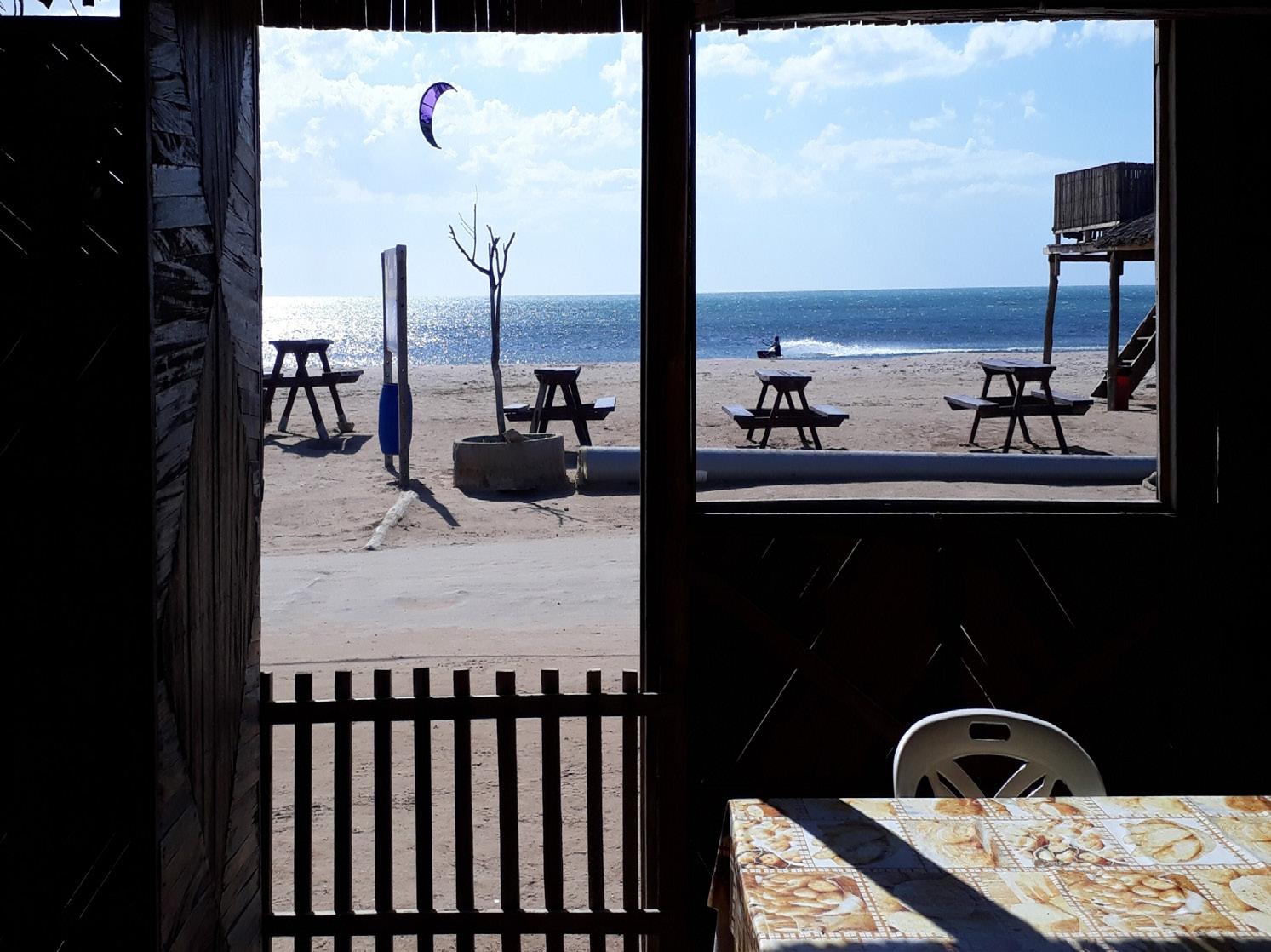
According to statistics from the Sexual Assault Centre Kingston, one in four students at Queens will experience sexual violence during their time here. 58 per cent of Queen’s students see sexual violence as a problem at Queen's. This number increases when looking at students who identify as women, non-binary, and Two Spirit.
Alarmingly, only three per cent of students identifying as women and 14 per cent of students identifying as men do not see sexual violence as a problem at Queens.
Queen's defines sexual violence as “any sexual act or act targeting a person’s sexuality, gender identity or gender expression, whether the act is physical or psychological in nature, that is committed, threatened
The numbers these statistics represent increase when marginalized groups such as gender-diverse people and Indigenous folks are looked at separately.
Earlier this year, there was a report of a young woman being spiked by a needle at Trinity Social and a report of a young woman being assaulted on Brock and University late at night. These reported incidents are not isolated.
Students living in the University district have faced scrutiny for misogynistic signs proudly displayed outside their homes during Homecoming and Frosh Week celebrations. The people who make these signs and those who walk by with laughter or indifference contribute to a culture normalizing the behaviour that often enables sexual violence at Queen’s.
There's a strong, well-documented connection between binge-drinking, and sexual assault.
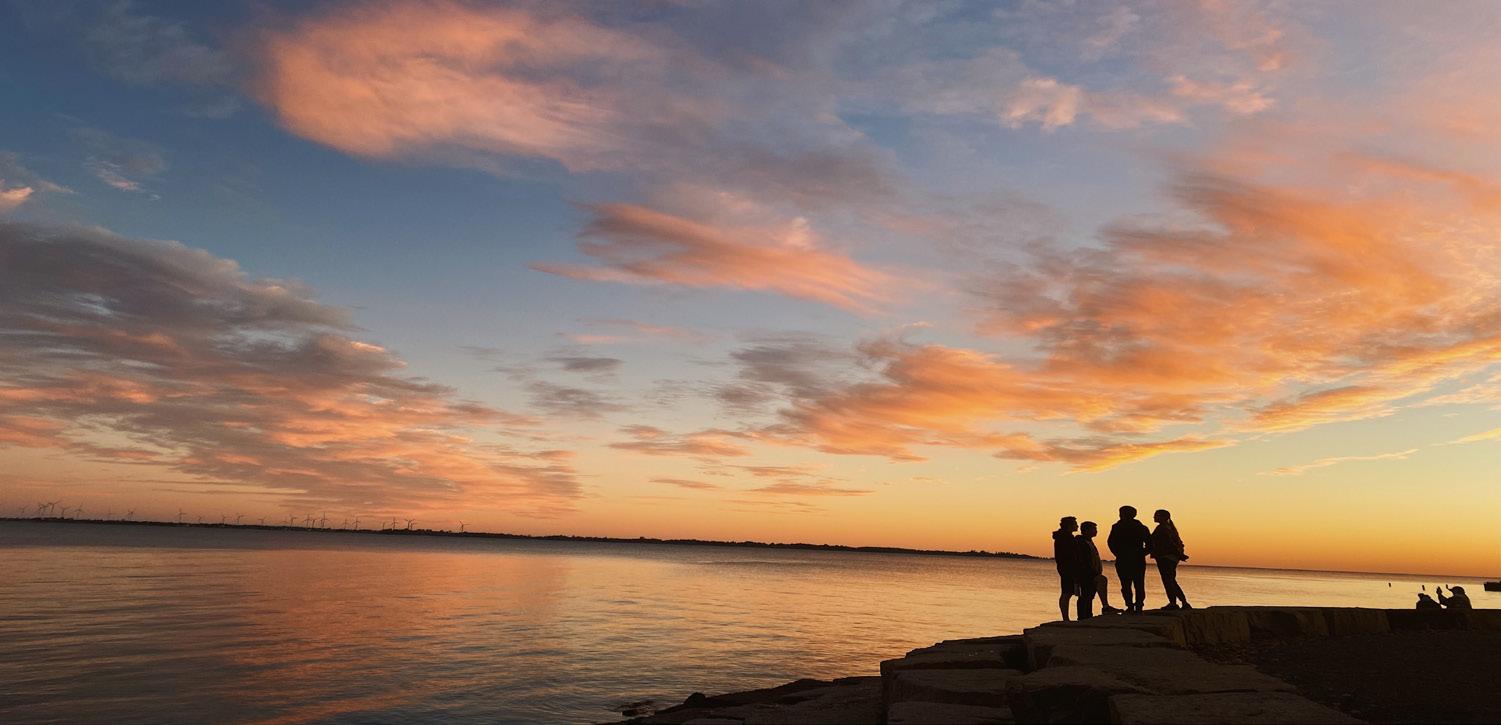
When you drink, your inhibitions are limited. You feel invincible. Combine the social culture of binge drinking and positions of privilege and power, and this feeling of invincibility makes some people think it’s acceptable to take advantage of others in precarious situations.
Students should not feel unsafe a block away from home, two blocks from a friend’s home, or anywhere in the student neighbourhood. No one should have to run home and lock all their doors and windows, fearful for their safety.
Despite the idealistic Queen’s “bubble” we tend to live in, our community is not safe from sexual violence. It's likely that almost every individual attending this institution has experienced, witnessed, or heard stories about it.
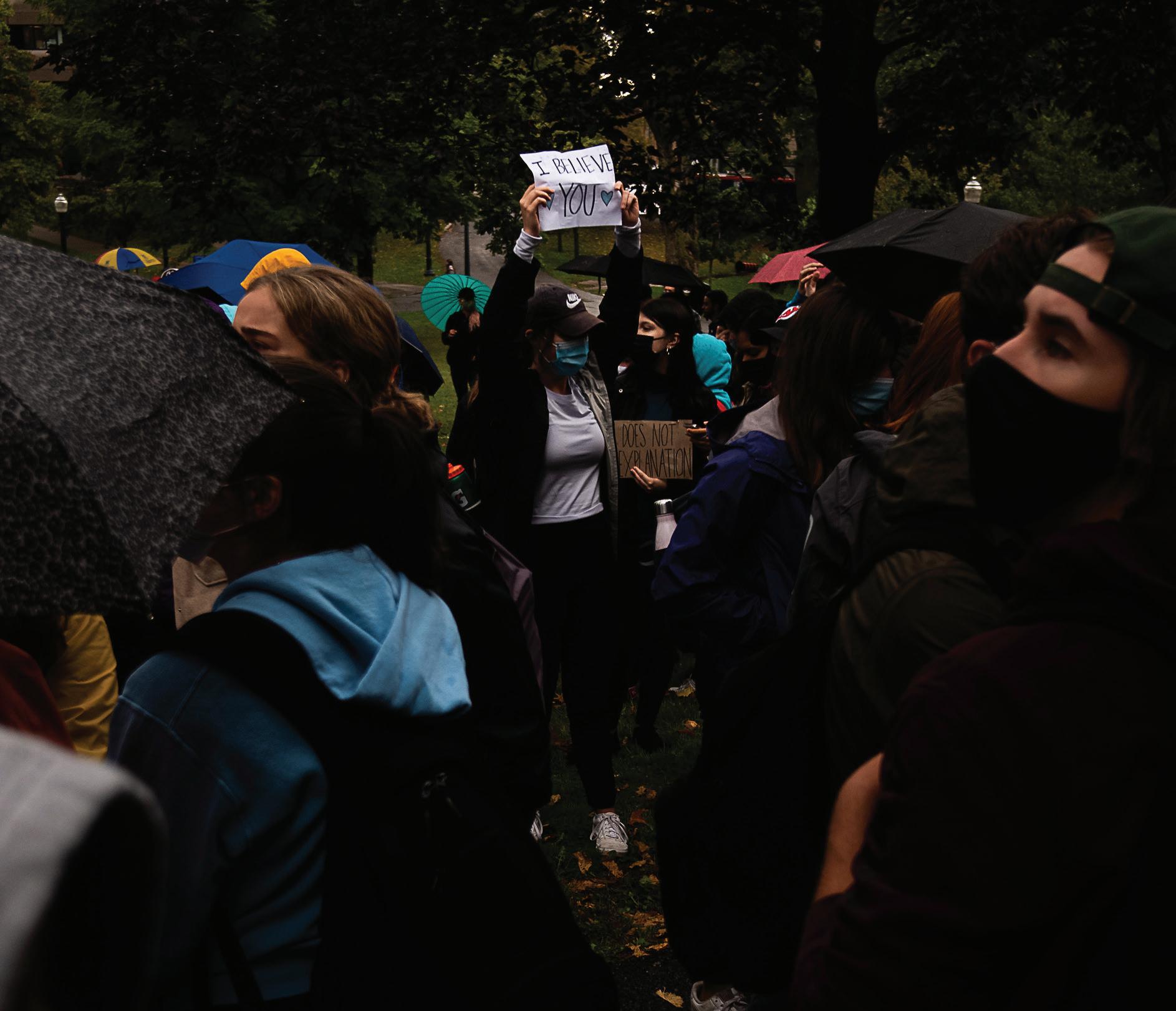
Students need to better understand consent. It's enthusiastic, informed, and ongoing in whatever sexual activities they choose to engage with. Unfortunately, according to the Canadian Women’s Foundation, only 28 per cent of Canadians know this definition.
"It’s clear students need to do better, and we need more help from this institution to get there.
Consent is co-opted by positive body language and a clear “yes”. Your consent can be withdrawn at any time and for any reason. Any form of coercion or guilt-tripping from your partner is absolutely in violation of your consent, regardless of whether you’re with a long-term partner.
The institutional body of Queen’s also has a responsibility to fill these gaps with
education and sexual violence prevention services. Only 30 per cent of students have received information or training on the definition of sexual violence and the resources our school has in place to address it.
Instead of donating hundreds of thousands of dollars to the City to increase police presence in the University district during Homecoming and St. Patrick’s Day, the University should be funding sexual violence awareness, education, and prevention initiatives on campus.
It’s clear students need to do better, and we need more help from this institution to get there.
Sophia is a fourth-year Global Development student.
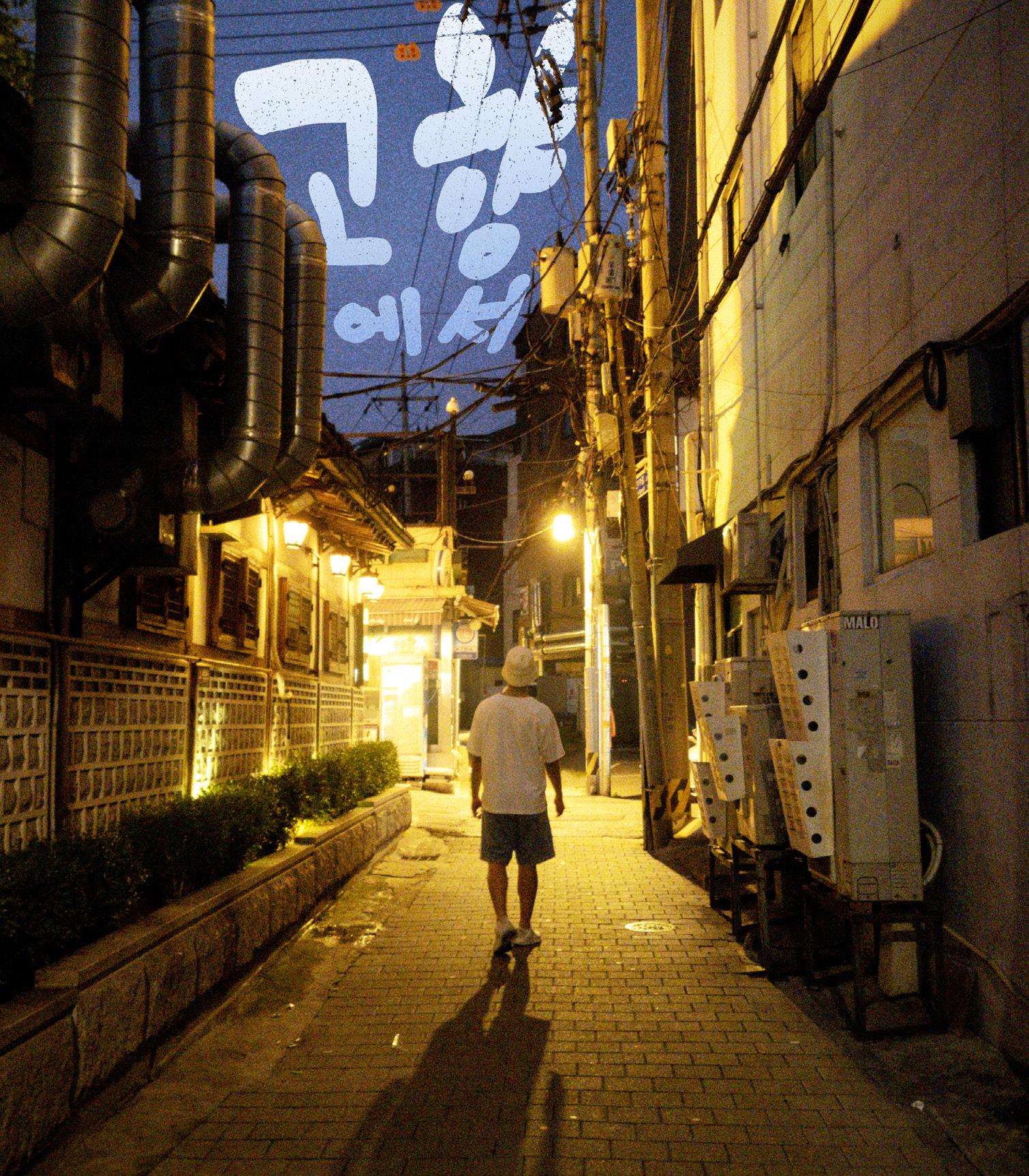 Students rallied against sexual violence at Summerhill on Sept. 27, 2021. JOURNAL FILE PHOTO
Students rallied against sexual violence at Summerhill on Sept. 27, 2021. JOURNAL FILE PHOTO
The university's prolific party culture has harmful consequences Contest Winners
PHOTO BY MELANIE ESCOBAR
PHOTO BY
La Guajira
PHOTO BY JUAN DUENAS
OpiniOns8 • queensjournal ca Friday, 23 september, 2022
Fall Photo
Gord Downie Pier
At Home
AREN JO
TIFF 2022 coverage: upcoming releases to watch

Weird Al biopic and Steven Spielberg’s first appearance at TIFF among highlights
Luc Lafontaine Contributor
Every September, the film industry sets its sights on Toronto. Featuring a wide variety of films, the Toronto International Film Festival (TIFF) allows both the press and the public to watch the industry’s newest releases. Here are some of the highlights of the festival, all set to release within the next few months.
The Fabelmans
After providing the world with countless filmmaking innovations, Steven Spielberg’s newest film reflects on his childhood and what piqued his interest in filmmaking.
Acting as an autobiography in film form, The Fabelmans is a masterful family drama and Spielberg’s most personal project. Unapologetically cheesy and full of heart, it explores Spielberg’s childhood as he finds his passion with his family on the verge of drifting apart.
Beyond being about filmmaking, The Fabelmans is a moving portrayal of family dysfunction and the pursuit of passion. This is further enhanced by powerful performances by Gabriel LaBelle, Paul Dano, and Michelle Williams.
Through its subject matter and execution, The Fabelmans reaffirms the importance of the moviegoing experience. This film exceeded all expectations and absolutely deserved the TIFF People’s Choice Award.
Now with 34 feature films under his belt, Spielberg still has it.
The Banshees of Inisherin 2017’s People’s Choice winner Martin McDonagh returned to TIFF with his newest drama/black comedy, once again proving he’s the master of making people question whether or not they should be laughing at what they’re watching.
Set in 1923 on a fictional island off the coast of Ireland, the film follows the abrupt ending of a lifelong friendship and its disturbing consequences.
Equal parts hilarious and uncomfortable, The Banshees of Inisherin reunites Colin Farrell and Brendan Gleeson for a unique film about friendship and loneliness. Emotionally complex and deliciously unpredictable, the film expertly balances drama and deadpan comedy.
Weird: The Al Yankovic Story
Continuing the saga of Daniel Radcliffe starring in the weirdest movies possible—see Swiss Army Man and Horns Weird: The Al Yankovic Story is a movie whose title doesn’t disappoint. It’s an absurdly funny parody of musical biopics, and it most definitely is weird.
It’s fitting that the story of Weird Al, long-time writer of parody songs, is itself presented as a parody of musical biopics and their tropes. Co-written by Weird Al himself, the story takes creative liberties in
telling his story that help it stand out from other Hollywood biopics.
From his first moment he’s onscreen, it’s clear Daniel Radcliffe is having fun with this role. His energy is infectious, and he was a great choice to play Weird Al.
Along with solid supporting performances by Evan Rachel Wood and Rainn Wilson, director Eric Appel delivers a crowd-pleasing comedy and a glorious celebration of weirdness.
Good Night Oppy
This film is a pleasant surprise. Informative, exciting, and even touching, Good Night Oppy is an incredible documentary by Ryan White.
The film follows Opportunity, a Mars rover which was only supposed to last 90 days, but instead lasted for 15 years, capturing the public’s interest and imagination in the process.
Not only does the film follow Oppy in a stunning CGI recreation of Mars, but it also follows the lives of the people who worked tirelessly to take exploration to its limits. We get to see how the team behind Oppy grew attached to the robot, and how the events of the mission coincided with their personal lives.
Overall, Good Night Oppy is a wonderful documentary, and an interesting exploration of human capability—both technologically and empathetically.
Sweet As
Partially inspired by herchildhood, director Jub Clerc’s Sweet As is a tender coming-of-age story and an impressive feature debut.
The film follows Murra, a 15-year-old Indigenous girl in western Australia as she embarks on a week-long photography trip to escape her home life. Initially unenthusiastic, she slowly begins to express herself through photography and finds herself bonding with her company on the trip.
Shantae Barnes-Cowan delivers an excellent performance as Murra. Combined with a strong ensemble cast and great character moments throughout, Sweet As feels personal and authentic to real life.
***
Overall, TIFF 2022 provided a good look at some of the year’s most anticipated releases, including The Fabelmans, The Banshees of Inisherin, and Weird: The Al Yankovic Story
While it’s exciting to watch these anticipated releases early, films like Good Night Oppy and Sweet As show the fun of film festivals can also be taking a chance, watching something you know nothing about and potentially discovering a hidden gem.
Logos are art too
From checks to stripes, logos are intensely personal
Sam Goodale Assitant Arts Editor
A great logo shouldn’t just sell you something—its purpose shouldn’t end with its function as a strategic tool. A logo embodies a brand’s identity and, ultimately, our identity in relation to the brand. Good logos will increase sales, sure, but great logos are beautiful.
Think about your favourite logo: maybe it’s the iconic Nike swoosh or the half-eaten fruit on the back of your Apple laptop. Both designs are beautiful in their simplicity and efficacy; they each effectively embody a brand while evoking a response within us based on our perception of the brand. They’re provocative pieces that incite an emotional reaction.
There’s something interesting in the composition of these two logos: nowhere can we find the words “Nike” or “Apple” within them. Instead, we have a swoosh and a literal apple.
There are symbols and metaphors in logos, both of which we widely associate with art. Logos themselves are—to use the fancy academic term—visual metonymies for their entire brand. They are imbibed with meaning to provoke a certain reaction from their viewers.
This is not to say that logos are exactly the same as what we think of as fine art.
For instance, The Starry Night probably wouldn’t be as good at selling chicken nuggets as the Golden Arches. Logos are meant to be far simpler than what we find art gallery walls of galleries, but that doesn’t discount the thought and care that goes into designing a beautiful logo.
There is also, of course, a discrepancy between the motives for creating logos versus creating fine art. Logos are meant to sell things to you. Traditional art is meant to be moving, emotionally stirring, and tell us something about the world and what it means to exist in it.
The merits upon which logos are judged differ as well.
For a company, a good logo sells more of your stuff. That’s it. How we judge good art, though, is something nobody agrees on. There is, then, a utilitarianism to the function
of logos that prevents them from being viewed with much subtlety. However, the pragmatic judgement of logos and the imprecision of artistic criticism belies that both can be, and are often, beautiful.
Seriously, a good logo can sell you a pair of running shoes, and that’s perfectly fine. That doesn’t mean it isn’t a piece of art. Something can be practical and beautiful.
That’s where the artistry of logos ultimately lies: their ability to do something useful and embody meaning not readily available to our eyes.
Great logos are also just fun to look at. It’s cool holding your Starbucks cup and seeing the green mermaid printed on the side. It’s nice reading a book and having the cute orange Penguin logo on the spine. Ultimately, logos can look good and enhance our experience with a product.

Because of this, logos are intimately attached to our experiences.
The Lego logo is beautiful. The red background with the yellow outlined “Lego” is aesthetically pleasing and perfectly encapsulates the toy’s simplicity.
However, when you see that logo, its impact goes a lot deeper than its appearance. Who didn’t love Lego as a kid? Whose memory isn’t filled with late nights following crumpled booklet instructions by the light of a TV? Regardless of what you were building, no matter how big or small, on the box and on the booklet, there was the Lego logo.
Now when we see that red box again, it holds a far deeper meaning. It transports us back, momentarily, to days spent clicking small plastic blocks together and the joy we felt when we finished putting a set together.
Great logos can do so much more than sell. They can be beautiful, represent what we want to be associated with or how we wish to be perceived. They can be time machines.
So maybe the Nike swoosh isn’t the Mona Lisa, and maybe the three stripes aren’t The Birth of Venus. That’s okay. There’s beauty in simplicity, and delight in the colour of it all.
Taking a chance on a film can reveal a hidden gem.
GRAPHIC BY AMNA RAFIQ
Logos find beauty in their simplicity.
GRAPHIC BY AMNA RAFIQ
ArtsFriday, 23 September, 2022 queenSjournal ca • 9 ARTS
Rida Chaudhry Senior Arts Editor
Storytelling through film is something we all enjoy, whether it be going to the theatre to see a new movie or rewatching one you hold close to your heart.
The Journal sat down with Taryn Resende, ArtSci ’23, and Lauren Thomas, ArtSci ’23, to talk about what drives their passion for film and how they choose to explore it.
Resende’s interest in the movie-making industry began with her mother, who worked in film and made sure to expose her to the best children’s movies.
“I remember one that really captured what made me want to go into film was Labyrinth by director Jim Henson,” Resende said. “There’s this scene where this bubble and they do it in a way that’s used with a telescope—I found it fascinating that you can make magic possible without using digital technology like we see today.”
The movie magic we see today is often done with CGI technology—opening up easier pathways to special effects— but Resende cherishes the ‘behind the scenes’ excerpts from earlier movies that showed how those effects used to be done more practically.
Resende is frequently drawn to directors Sofia Coppola and Wes Anderson.
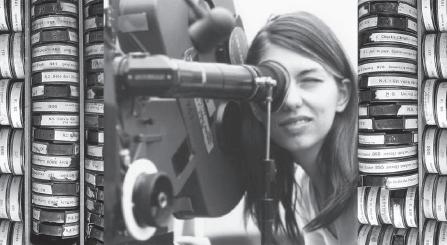
“I love [Coppola’s] auteur, she’s an LA girl and really cool with this unique style to her. The Virgin Suicides is unreal—I absolutely love that movie and the simplistic way she creates dreaminess through a haze and curated an amazing soundtrack.”
As a Film & Media student, Resende has dedicated her
What’s your medium?
A look into the brains of two film enthusiasts
“You’re not just inside of the story, but inside of like the mechanisms of the machine how it was made by all people.”
Thomas is keen to look at how a filmmaker’s perspective shines through their creations—her favorite films unapologetically embrace such perspectives and celebrate them.
“The Bader centre released an experimental animation movie called Tori Pines for the Reel-Out Queer Film Festival—it’s weird, it’s animated, and it’s autobiographical.”
“The film follows a young girl’s perspective who grows up to be a trans man; I love how this person’s story was told, but also the innovation of the film itself.”
Thomas can’t choose a favorite project she’s worked on because to her, each one has brought her a new perspective and honed skills she takes with her to the next.
“I try to celebrate distinct perspectives of people I interviewed in my videos for The Journal, like with my video for Francisco and his art. I had the camera follow his body and movements as he painted to give the audience a glimpse into his perspective.”
academic career to learning more about the industry. She watches film by engaging with the messages and feelings emulated on the screen.
“Although we study it, watching movies is kind of like an escape from reality. Sometimes watching movies creates a spark of of inspiration you didn’t think you’d ever have.”
Resende’s mother told her the best thing about working in film is the power to influence people’s perspectives—she’s mindful of this when reflecting on potential production ideas.
“Film is my life; I remember in first year I didn’t know where to go with this passion, but now having some experience on sets as shown me that I love the creative side of film.”
Resende’s favourite movie is The Dreamers. She loves how it shows the romanticization of life, making observations on love, war, and peace as its characters come of age.
Thomas’s experience in film has been similar, albeit through a different lens.
“The Winnie the Pooh movie was probably the first one that stuck out
Posthumous releases and life after death
Our responsibility to artists who are no longer here
Sam Goodale Assistant Arts Editor
The end of an artist’s life does not signal the end of their career.
Rather, the death of a musician, actor, or writer, often spurs a revival of their popularity that frequently coincides with a posthumous release.
Although they can provide closure to an artist’s career, posthumous releases are rarely of the same quality as work produced in an artist’s life. Many of them also exploit a person’s death for profit without the artist’s expressed consent to have their work released.
Of course, there’s great variation in posthumous releases—some are very good, and some are not very good. For instance, Kafka’s The Trial is a masterpiece, and although it was never completed, Kafka’s voice is preserved after his death.
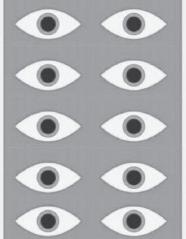
With that said, it feels unsettling to judge posthumous releases based on their merits—we’re
discussing something that’s been released with at least the partial intention to memorialize a person who’s died, after all.
Judging posthumous releases is tricky. However, there’s a reason most of these things weren’t released while these artists were alive: they weren’t finished.
We can see this in posthumous albums rife with features, with the original artists taking a backseat role in the actual content. Musicians now often get two posthumous releases which only compounds the lack of substantial new music actually being released.
Additionally, would artists even want their work to be released posthumously?
There must be a reason it wasn’t made available while they lived. Should it really be within the power of record executives and publishers to decide if an artist’s work is shared if they cannot consent? Surely they deserve to have control over their art even in death.
Ultimately, the absence of considerable material to constitute a new release and the lack of artist consent makes posthumous work seem exploitative as record labels and publishers
use increased awareness to increase sales.
Sometimes the profits go to charitable causes, but this is not always the case—either way it does not negate excuse executives for releasing material that is not theirs.
On the flip side, though, there’s an argument to be made in favour of posthumous releases.
They memorialize the artist—they’re a farewell to the world. There’s also a clear demand for these releases: people want more content from the artists they love, so why should we withhold it from them?
Regardless, how we feel about posthumous releases will likely vary widely between artists and how we feel about the ethics. It might be legal for us to release an artist’s work after they die, but is it moral?
We must ask ourselves who is truly benefitting from these releases. When posthumous albums chart at number one on Billboard for weeks, who really profits?
Executives should feel a massive burden of responsibility to ensure posthumous releases
to me when I was in kindergarten,” Thomas said. “There’s this nightmare that they show that’s very trippy and surreal.”
Thomas’s observations while watching movies made her in tune to changes in speakers, microphones, angles, and perspectives.
“There’s kind of like a threshold where you’re watching a movie. You’re just inside of the story, but whenever you realize that movies are something that are made by another person who is human just like you, it opens up a whole new, exciting and really interesting way to watch [them].
are handled sensitively. Maybe it could be something like asking an artist about releasing posthumous work and getting their permission beforehand. Regardless, they must seek to honour their lives and not profit off their deaths.
This is not to say that posthumous releases are void
Thomas stressed that no one person is more of an expert in film than another—she encourages readers to embrace the variety of perspectives found in film.
“Films really celebrate that power of being able to do something about the private thoughts in your head.”
Thomas told The Journal her personal goal is to build her auteurship—this film term refers to the recognizable, distinct stylings of a film maker.
“When people watch my films, I want them to get a sense of ‘oh Lauren made that movie!’”
of value, but there needs to be a reconsideration of how we do them.
It’s wonderful that these artists continue to bring joy to people’s lives after death. However, we must ensure our joy does not come at the expense of their memory.
Conversations on why we consume art the way we do.
GRAPHIC BY RIDA CHAUDHRY
Posthumous releases should honour, not profit.
GRAPHIC BY RIDA CHAUDHRY
Arts10 • queenSjournal ca Friday, 23 September, 2022
‘Exactly what we needed’: Football wins big at home
Stands packed as Queen’s beat Ravens 49-17
Sarah Maat Senior Sports Editor
The energy at Richardson on Saturday was electric. The stadium felt like it was pulsing, and Gaels football channelled all that energy into a win as they wrecked the Ravens.
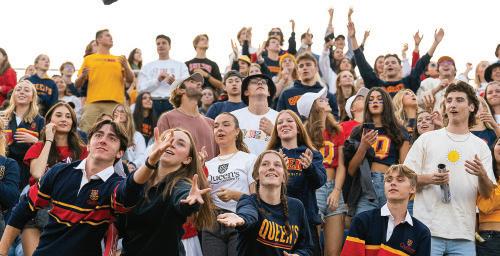
“It was exactly what we wanted and exactly what we needed,” Head Coach Steve Snyder said in an interview with The Journal
“That energy you can’t fake it and it goes a long way for a football team. What the students need to understand is they are not coming to watch the game; they are coming to participate in the game. And if they’re into it, it makes a difference.”
The whole Queen’s community coming together created a winning atmosphere at Richardson.
Students lined up all the way out of the parking lot waiting to be let in, Gael buses helped charter fans to and from West Campus, and alumni showed up donning their ancient tricolour outfits.
The cheer teams never stopped supporting, and Queen’s Bands gave the football team a well-deserved grand entrance. In response, the football team put on a show.
After the Ravens scored an unlucky single during the first kick, Gaels decided to take control. Less than a minute into time, James Keenan ripped a 42-yard pass to Nicodeme Kwemo, bringing in Queen’s first touchdown.
From that play onwards the stadium was alive.
Many fans sang the oil thigh alongside Queen’s Bands and
the cheer squads came to life. The tricolour spirit overwhelmed.
Queen’s set the tone with that first play and followed through.
In the first quarter, Queen’s Yann Longa and Nathan Falconi each put up touchdowns of their own. The Ravens only responded with a field goal.
At the start of the second quarter, Aidan O’Neal scored a touchdown of his own.
From there out, O’Neal was a critical part of the action as he and Richard Burton each went over 100 yards receiving during the game.
“It’s nice to have [momentum] on your side, you don’t want to lose [momentum], and it’s awesome just to take it right away, first two snaps of the game,” O’Neal said in an interview with The Journal Queen’s went out and did what they had planned to do.
As O’Neal described post-game,
they worked on “executing [their] responsibilities,” “resetting every play,” and “not getting too far ahead of [themselves].”
Keenan only had positive things to say about his receivers and their work ethic.
“We have a great receiving core. Everyone loves each other and everyone loves to help each other out,” he said.
The Players kept up their energy into the second half, but the fans seemed to bring even more to the table. Cheering exploded after each touchdown, the Pom Squad performed during a timeout, and the sea of tricolour moved in unison with the band.
The fans were so engaged they even noticed, and cheered on, a squirrel that ran all over the field in the middle of a down. The team couldn’t have asked for a better environment.
“It feels good to know that we have our own of that huge
crowd and that atmosphere is awesome,” O’Neal said. “If this is the experience, then I’m in love with it.”
“I love seeing the students out, it’s such a huge help when they get out here. They were loud. I could hear them at multiple times during the game so that was awesome,” Keenan echoed.
After the last rendition of the oil thigh finished, the scoreboard read 49-17. The Ravens were no match for Queen’s football and fans.
“These guys are so proud to play for Queen’s and become the spirit of the school, so I think its tremendous, I’m so glad [the fans] were there, and I think they got a great show,” Snyder said.
The show was so great, in fact, that it earned Queen’s football the 4th spot in the U Sports Top Ten ranking—the highest spot they’ve seen all season.
Football’s next home game is Oct. 1 at 3 p.m. against the York Lions. Don’t miss out!
Women’s soccer keeps a clean sheet against RMC
cross that Mattie Strikler put it in the back of the net.
Sarah Maat Senior Sports Editor
The rain came down on Sunday at Richardson Stadium, but that didn’t stop the Gaels as they demolished the RMC Paladins 10-0.
It was a showdown against two home teams, but because of the horrible weather, the stadium didn’t reflect that. However, Queen’s didn’t let the almost empty bleachers get them down as they prepared to mimic the victory they earned in 2021—the last time they played RMC.
Minutes in, Queen’s took control. Cecilia Way dominated in the Paladins end and, minutes after the first whistle, sent a beautiful
From there they were off; the Gaels could not be touched. Mere seconds after her assist, Way landed a goal of her own to put Queen’s up 2-0 barely two minutes into the game.
They were clearly dominating and kept the ball in the Paladins end—the ball might not have even known Queen’s net existed.
Around the 12-minute mark Raya Athwal joined the action with a goal of her own. She’s getting really good at finding the back of the net.
Queen’s kept the shots up and shared the ball amongst themselves as they refused to pull back the pressure. RMC responded well as their goalie, Breanna Habinski, made some memorable saves—OUA Plays of the Week
recognized one where she denied Way.
Jenna Matsukubo earned her first goal of the season after getting fouled inside the box and putting up a killer penalty kick.
Almost as numerous as their shots, however, were the offsides called against them. Queen’s struggled to pull off a clean attack as the offside calls negated several chances.
However, Seema Sakran wasn’t shaken by the offside calls as she and Way put on a show at the end of the first half. Sakran scored a point and, three minutes later, Way put up one of her own. They teamed up for two more goals before the 45-minute mark, with Way assisting both.
Sakran’s display at Richardson earned her the title of Queen’s Athlete of the Week.
It was brutal for the Paladins and the start of a new half
didn’t offer much hope. Queen’s continued to activate their back line as they kept up the pressure. RMC could not escape as Alicia Sutcliffe and Izzy Pineda added two more goals.
Finally, a corner kick in the 81st minute gave the Paladins
an opportunity inside the Gaels box, but they didn’t score.
The game ended with a 10-0 victory for Queen’s as the Gaels were victorious in the battle between two hometown teams.
Women’s Soccer will play next on Sept. 24 at Laurentian, the first of three away games in a row.
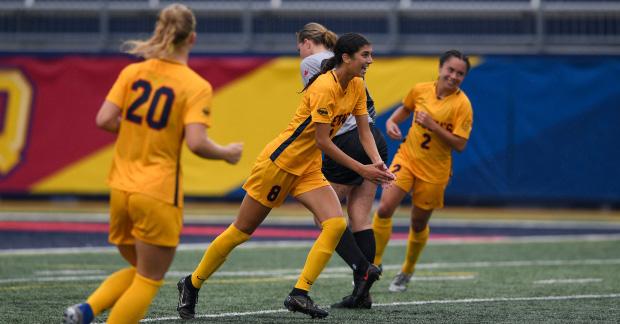 Gaels will be back at Richardson Stadium on Oct 1.
PHOTO BY CURTIS HEINZL
Seema Sakran celebrates her hattrick.
Gaels will be back at Richardson Stadium on Oct 1.
PHOTO BY CURTIS HEINZL
Seema Sakran celebrates her hattrick.
Paladins no match for Gaels’ double digit score
PHOTO SUPPLIED BY ROBIN
SportSFriday, 23 September, 2022 queenSjournal ca • 11 SPORTS
KASEM
No one scores against Queen’s rugby
Sarah Maat & Lilly Coote Journal Staff
Women’s Rugby beat Western 53-0 on Sept. 17. The next day, Men’s Rugby followed suit and kicked off their 2022 season with an impressive 57-0 win over RMC. Both Queen’s teams are proving they’re a force to be reckoned with on the rugby pitch.

Women’s Rugby stays consistent
Women’s Rugby has held the first spot in the U Sports Top Ten rank thus far, and weren’t willing to give it up on Saturday against the Mustangs. They weren’t willing to give up any tries, either.
Throughout the 2022 season, the Gaels have shown off their quick transitions and this game was no different. Grace Anderson put up their first try off a quick transition.
The Gaels also laid down a crisp defense to which the Mustangs responded with sloppy plays as they struggled to make much progress with the ball.
Lizzie Gibson led Queen’s in scoring once again with 16 points. Her reliable conversions have been crucial in helping the Gaels rack up the points; she earned the Queen’s Athlete of the Week award last week.
Carmen Izyk made a dent on the scoreboard by putting up three tries of her own.
However, Queen’s was sure to share the love; Sophia Tafel, rookie Maddie Donnelly, and Emily Butterworth all put up points of their own too.
The scoreboard showed a decisive 53-0 victory for the Gaels when the final whistle blew.
Queen’s promised a season worth watching, and they’ve delivered. They’ve put up a whopping 222 points so far, but the lack of tries against them is more impressive.
Right now, the Gaels have a tight grip on their 2021 U Sports championship title. They’re inviting students to get out there and watch them continue to defend it.
Men’s Rugby off to a solid start
Despite the cold and rainy weather, the bleachers were packed with fans in rain jackets cheering on the men’s team at their home opener.
The last time the Gaels challenged the Paladins was in October 2021, with a triumphant win of 48-0. Fans were ready to see a repeat demolition.
Queen’s was awarded a try within the first minute of the game, foreshadowing a strong theme of Gael domination for the entire half.
Despite the Paladins’ best defensive efforts, the Gaels only had to wait another 16 minutes before scoring again. Then with less than four minutes left, the Gaels scored again, closing the first half of the game with a tight rein over the lead at 33-0.
The second half started out strong, with Eric Godden and Adam Doyle scoring tries to bring the score up to 45-0. After some hot potato passes and quick ball handling skills,
the Golden Gaels scored another try with only nine minutes remaining.
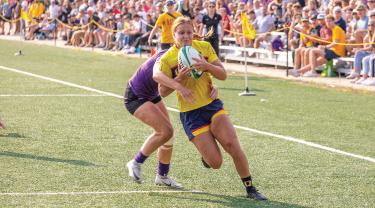
With no time left on the board, the forwards fought a hard battle to win the game’s final points—the final score read 57-0 after the conversion kick.
The Paladins had a strong defense, but the Gaels were dominant with their forward play and unpredictable passes.
Head Coach David Butcher is determined to keep playing quick-paced games this season.
“We’re going to play a very fast, fluid brand of rugby. And we’ll also be investing in our kicking game; we’ve got two fly halfs that can really kick the leather off the ball. It’d be remiss of us not to utilize that,” Butcher said in a press release.
Looking ahead, the men’s team will host the Western Mustangs at Nixon Field on Saturday, Sept. 24 at 3 p.m. On that same day, the women’s team travels to Hamilton to play the McMaster Marauders at 6 p.m.
Men’s Soccer secures first victory
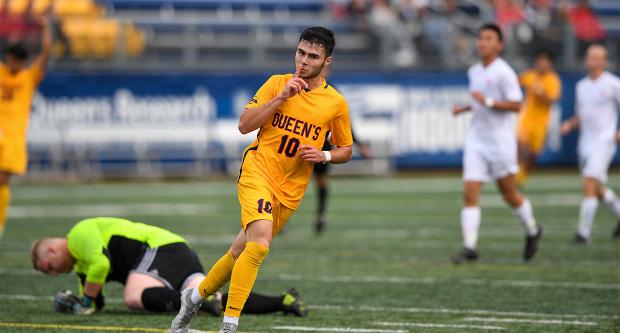 Sarah Maat Senior Sports Editor
Sarah Maat Senior Sports Editor
On Sunday, Men’s Soccer met RMC on home turf.
These hometown teams both stepped onto the field suffering with the same unfortunate record: zero wins, two losses. In a battle to see who could turn their luck around, Queen’s pulled out a 6-1 victory.
“It feels like we’re heading in the right direction,” Head Coach Christian Hoefler said in a press release.
The game started with a lot of back-and-forth possession. Neither team held the ball long enough to get a proper shot off.
This changed when Queen’s started to take advantage of their speed. Andrea Gortana took control offensively and began setting up opportunities for Queen’s to advance the ball.
However, just because Queen’s offensive line was dialed in, it didn’t mean they could neglect their back row. They delivered particularly balanced attacks when they looked to their defensive players for support.
In the first half, their work started to pay off; both Gortana
RMC did a good job of holding their own against these attacks, but really struggled to get shots off throughout the whole first half. Luckily for RMC, their lone shot landed, keeping them in the running.
When the second half came, however, something clicked for the Gaels. They played in ways we haven’t seen all season.
“If you saw the second half, we knew that if we applied what we’re doing in training and we’re executing, we get a result,” Hoefler said. “There was that cohesion and there was that belief and an understanding between them.”
Gortana started the second the same way he had the first, but this time his goal had an insane ripple effect as Noah Campagna followed with a point of his own.
Pablo Hempelman-Pere and
Nico Mesiano couldn’t let those two have all the fun, so they also each scored one. The Gaels spread all four points out evenly over the second half. RMC couldn’t touch them; they struggled to hold the ball as Queen’s demonstrated their rule over Richardson Stadium.
By the time the final whistle blew, Queen’s had broken their losing streak and redeemed themselves on home turf. Looking ahead, the men’s soccer team will
have four away games in a row, but Hoefler says his team is prepared.
“It is a little bit of a journey for us to head out there, but, as long as we execute and just stick to our plan and bring that energy we brought in the second half, I’m very confident that we’ll perform.”
Keep an eye out for their next game at Laurentian on Sept. 24.
Women’s and men’s teams shut out Western and RMC
The Gaels physically outmatched RMC.
PHOTO BY HERBERT WANG
PHOTO BY HERBERT WANG
The Mustangs weren’t fast enough.
and Pablo Hempelman-Pere found the back of the net.
After a slow start, Gaels demolish RMC in the second half
PHOTO SUPPLIED BY ROBIN KASEM
Andrea Gortana celebrates a goal.
SportS12 • queensjournal ca Friday, 23 september, 2022
journal_sports@ams.queensu.ca
Men’s Hockey: What to expect
Gaels striving for redemption
Lilly Coote Assistant Sports Editor
After a devestating loss at the OUA playoffs last March, Men’s Hockey is looking forward to a fresh start this season. Head Coach Brett Gibson has called this year one of redemption.
“We had a fantastic season last year, but obviously it ended in a very disappointing way,” Gibson said in an interview with The Journal.
Last spring, the Gaels lost their final game in an overtime battle against the McGill Redbirds, finishing with an overall record of 17-3.
“We want to prove how good we were—how good we are—and it’s a great opportunity in front of us now that we have the whole OUA East to play,” Gibson said.
The Gaels are off to a strong start this year, winning two out of their three pre-season games. Most recently, however, the Gaels lost to the Laurier Golden Hawks with a final score of 4-0.

Although Coach Gibson believes the Gaels played well during the other two preseason games, he acknowledges they got away with some mistakes that caught up with them against Laurier.
“It’s better to happen in the pre-season, and I was actually happy we didn’t get the result we wanted to,” he said. “We’ve got a lot to work on.
We are far from a perfect team right now.”
Former team captain Patrick Sanvido, BEd ’22, will join the team’s coaching staff for the 2022-23 season.
Gibson said he loves having former players work beside him, as it reinforces the Queen’s hockey culture and family atmosphere on the staff team.
“To mentor Patty again into a role of coaching, he’s just a great human being. I already know his leadership qualities; it’s just
how do we communicate those leadership qualities as a coach and not a captain.”
The Gaels will have two more pre-season games against Waterloo and Western on Sept. 23 and 24 respectively before beginning their official season on Oct. 14.
With the last official game of the regular season on Feb. 11, Gibson emphasized the challenges associated with a season this long and is actively working to prevent burnout among players.
The key to keeping stamina, Gibson says, is communication.
“I truly believe it’s a partnership, not a dictatorship. I just have to listen to my players and listen to the people I’ve surrounded myself with.”
Gibson explained how he sees the season in three phases: the first phase is an introduction to the team, getting to know the players, creating relationships, and understanding the team dynamic; the second comes after winter break, where students get nearly a
month off school; the third phase is the sprint at the end leading into the OUA playoffs.
We are approaching phase one of the Gael’s hockey season; their first regular-season home game is on Oct. 21 against the uOttawa Gee-Gees. Gibson hopes to see Queen’s students cheering on their classmates in the stands.
“We love the crowds, and we need the help. We’d love to see everyone out that night.”
journal_sports@ams.queensu.ca
NBA drops the ball with Robert Sarver discipline
Phoenix Suns minority owner receives a slap on the wrist
Ben Wrixon Editor in Chief
On Sept. 13, the NBA concluded its investigation into Phoenix Suns minority owner Robert Sarver, punishing his workplace misconduct with a one-year suspension and $10 million fine.

As per the official NBA report, Sarver repeatedly used the N-word in conversation and made inappropriate, sex-related comments to female employees. Curiously, even with all this information, the investigation “made no finding that Mr. Sarver’s workplace misconduct was motivated by racial or gender-based animus.”
In light of this ruling, high-profile NBA players and media personalities have expressed frustration at the underwhelming discipline—for Sarver, who is reportedly worth around $800 million, the fine is little more than a slap on the wrist.
Unfortunately, this incident is just another example of professional sports leagues being afraid to truly make stern statements when it comes to harassment.
Back in 2014, former Los Angeles Clippers owner Donald Sterling was banned for life after racist calls between him and his then-girlfriend were made public. The severity of the unprecedented decision to exile Sterling satisfied most parties; they deemed he’d been appropriately punished.
However, in knowing what happened to
Sterling, the NBA’s recent unwillingness to put their foot down and exile Sarver looks even more cowardly. The groundwork has been laid for dealing with racist and toxic owners, yet, for whatever reason, they deviated from it.
LeBron James openly condemned the decision on Twitter, writing, “I gotta be honest… Our league definitely got this wrong. I don’t need to explain why. Y’all read the stories and decide for yourself. I said it before and I’m gonna say it again, there is no place in this league for that kind of behavior.”
In one of the stories in question,
Sarver used the N-word multiple times when discussing Golden State Warriors forward Draymond Green.
In interviews, his employees also recounted instances in which he passed around a photo of his wife wearing a bikini and bragged about her performing oral sex on him. They also recounted him asking women whether he “owned” them on several occasions.
Like James, superstar point guard Chris Paul voiced his displeasure on Twitter.
“This conduct especially towards women is unacceptable and must never be repeated,” he wrote. “I am of the view that the sanctions
fell short in truly addressing what we can all agree was atrocious behavior. My heart goes out to all of the people that were affected.”
PayPal, the current on-jersey sponsor of the Phoenix Suns, has stated they will not renew their partnership with the organization should Sarver return to the team post-suspension.
The company should be commended for this decision. However, it should not fall on them, the players, or social media to push the NBA to make the right choices. The league’s leadership and disciplinary bodies need to re-evaluate their decision-making processes.
From the Cleveland Browns rewarding known sexual predator Deshaun Watson with a five-year, $230 million contract, to Hockey Canada pocketing money to sweep assaults committed by their players under the rug, professional sports have a true epidemic on its hands.
Robert Sarver should be banned from the NBA forever. Deshaun Watson should never play another snap in the NFL. All of those involved in the Hockey Canada scandal should be fired.
On paper, these seem the conscious, logical punishments, but apparently, the politics are more important than holding people accountable and protecting their victims. It could be argued that the NBA may even be going backward when compared to 2014.
It may be time to clean house across professional sports. This Sarver fiasco is just the latest proof of how frighteningly behind the times these leagues and organizations are when it comes to handling assault and misconduct. We all deserve better.
The Gaels prepare for the upcoming season.
PHOTO SUPPLIED BY ROBIN KASEM
The punishment needs to fit the crime.
GRAPHIC BY CURTIS HEINZL
SportSFriday, 23 September, 2022 queenSjournal ca • 13
LIFESTYLE
Making your student house a home

Tips for creating a positive home environment
Aisha Mcintyre Contributor
The anticipated, but dreaded, day has arrived. You’re waking up at the crack of crazy to avoid Toronto traffic, your parents are having an existential crisis in the car, and you’re “helping” them lift heavy furniture up the stairs by carrying one blanket while your dad carries an entire couch.
You’ve waited an eternity for this moment. Your whole childhood, you’ve dreamt of getting the freedom to live your life without your parents providing their two cents on everything you do. No more rules, no more nagging to eat your vegetables, no more parents turning your Wi-Fi off at 10 p.m. every single night.
Yet, an hour later, once reality sets in, you’re lying on the floor, wondering what on Earth you got yourself into. You can’t trick your siblings into doing your chores anymore, you have to kill millipedes all by yourself, and you’re going ballistic.
Despite the quarter-life crisis everyone experiences after moving in, the experience is a vital one.
With time, there are things
you can do to make the transition as seamless as possible, prevent killing your roommates, and ensure your house does not grow a weird species of mould.
Here’s my best advice for making a house a home.
To make the transition between your hometown and the student ghetto easier, be sure to bring some of your home with you. Whether this is a sentimental item, family staple recipe, or pictures of old friends, it’s an amazing way to start your new chapter while reminding yourself of all the people who helped you get to this point.
Make plans with friends and family back home for when you come to visit. This will help ease homesickness by giving you something to look forward to. Don’t dwell too much on the past, though; make sure you are making new memories.
Once you move in, figure out some easy meals. I’m lucky enough to have a mother who taught me to cook as a young child, but for those who didn’t, I know how daunting cooking can be. I have a friend who lived on bread the first week she moved in because she never learned how to cook.
Don’t let that be you. Ask your family members for their favourite recipes, follow food pages on Instagram, and look some up online if you’re unsure. Roommates can be scary water to navigate,
especially if you’ve heard horror stories. However, there are ways to avoid the types of situations which seem to happen all so often.
It’s important you get to know your roommates’ preferences and personalities right from the start. This helps everyone learn what compromises they’re going to have to make to ensure everyone gets along and is comfortable.
You can do this through playing games like “Girls Night Out,” or simply by sitting down and having a conversation about what everyone’s expectations are for the house. Discuss expectations and boundaries early on—for quiet hours, having guests over, contributing to the cost of items, sharing spaces, cleaning, etc. If nobody is aware of the things
that bother each other, chaos ensues—chaos that could have been avoided had everyone communicated their needs.
If a problem does arise, address it respectfully; do not immediately lash out. Most issues can be resolved with a gentle reminder or short conversation that lets the other person know their behaviour doesn’t line up with previously established boundaries.
With the stresses of school, making new friends, and getting enough sleep, having conversations are imperative to make sure you’re all on the same page. Otherwise, you could face mental health struggles and exhaustion, and feel overall frustration with your housemates.
Finally, establish your own
traditions! Have baking nights, movie marathons, or nights out at the bar as ways to bond with each other and strengthen your relationships. University is a much better experience when you enjoy the people you are living with!
It’s incredibly important you make the house a positive environment not only for yourself but for your housemates. You all made a big step, and an even larger commitment to live on your own and with each other. The last thing you want is for your schoolwork to be impeded by avoidable personal and mental struggles.
With these tips, hopefully your only struggle this year will be working up the courage to kill the house centipedes.
Hustle culture doesn’t make way for healthy habits
A look into hustle culture at Queen’s
eliminates the few hobbies you have left by turning them into small businesses.
Clanny Mugabe Assistant Lifestyle Editor
Hustle culture is a phenomenon that’s spread from the real world’s expectation of constant progress and success—a by-product of the American or Canadian dream—into the Internet, where it’s morphed and mutated and burst back out into the real world in a new, worse, form.
In a school as competitive as Queen’s and a world as tough as ours, we’re immersed in a culture that values success over all else. Success is essential for our grades, job prospects, and survival in a challenging economy. Programs
like Commerce and Engineering in particular embody this need for success, developing reputations for being difficult and competitive in different ways.
On top of degree requirements, Queen’s is full of clubs and employment opportunities. Each one presents a new line for your resume—a new stepping stone to success. Internships, retail jobs, and 8 a.m. classes all add up in the end.
To succeed you need to hustle, and to hustle you need to sacrifice sleep, rest, and relaxation. Of course, we do it. For Queen’s students, grades matter the most, and in a competitive high-ranking
school like ours, you can’t afford to get a C or take a step back just to relax. There’s eminent pressure to meet a bar that’s a bit too high.
Of course, constantly working and never resting is extremely bad for your mental and even physical health. Work takes its toll, and a proper work-life balance is necessary to maintain a good lifestyle. It’s not good to always sit hunched over a desk and never see your friends, but the hustle culture mindset doesn’t allow for a healthy balance.
Instead, it insists on constant work and overloading your schedule with a new activity you can profit from in some way. It
Of course, I don’t want to dismiss the necessity of making money, and I don’t want to be condescending by telling hardworking university students what they already know. Every day, we’re inundated with self-care tips and mental health workshops.
But what can you do when deadlines are inflexible and bills need to be paid?
With inflation making everything cost more and gas prices staying high, of course the pressure to succeed weighs on us more than ever. So, I want to turn my critical eye away from students and look at Queen’s and the faculties within it instead.
Queen’s profits from having hard-working students and employees who work round the clock to maintain its pristine reputation. Recently, Queen’s has been offering more support for students as the importance of
personal health and safety has become a prominent topic in the past few years, and COVID-19 has exposed a lot of the flaws in how this university operates.

This still doesn’t change the fact that most faculties haven’t adjusted accordingly to curb the academic side of hustle culture.
When it comes to talking about mental health and self-care, the onus is often on the individual to take the time to reflect and step back to take care of themselves.
Students should come together to share the burden of work and lighten the load for each other. But we also need to look at the structure that guides our day-to-day and start thinking about the ways Queen’s could change to ensure we’re both educated and able to take care of ourselves.
Hustle culture shouldn’t mean sacrificing our physical and mental health for education.
There are things you can do to adjust to living on your own.
PHOTO BY HERBERT WANG
PHOTO BY CURTIS HEINZL
Hustle culture is as big as ever as life gets more challenging.
LifestyLe14 • queensjournal ca Friday, 23 september, 2022
Television’s most insufferable characters
Immoral characters send the wrong message to viewers
Maddie Hunt Senior Lifestyle Editor
As I sit down to watch Netflix, options of my comfort show spiral around my head. Though it really isn’t the plot lines or visuals I want to re-watch; rather, it’s some of my all-time favourite characters, like Nate Archibald, Brooke Davis, and Mark Sloan.
Then, right as I’m going to pick one of these adored shows to watch, I’m reminded of the insufferable characters who’re paired with my favourites, namely Dan Humphrey, Payton Sawyer, and Owen Hunt.
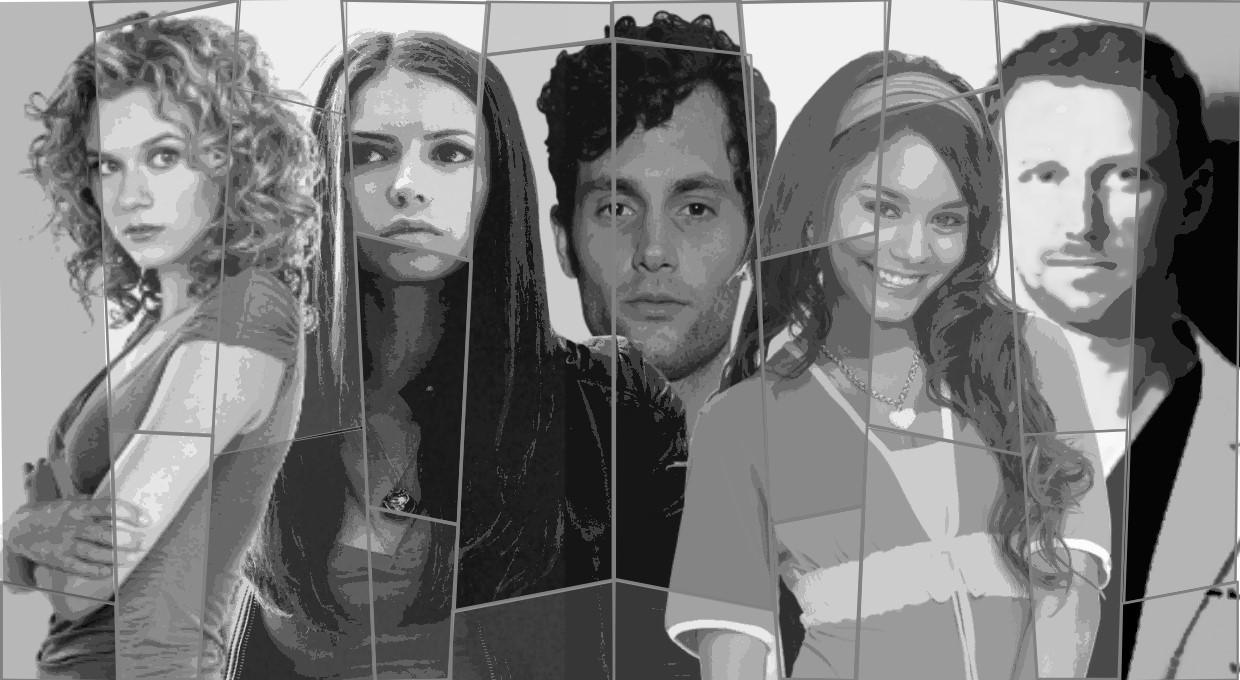
Don’t worry: Elena Gilbert also gets an honourable mention.
Not only are these characters painful to watch, but they’re completely immoral. Besides the obvious drama to keep you hooked, why do we subject ourselves to hours of watching characters who embody bad behaviour?
My first issue lies within a character trait they all share: they act like they’re pure, good people and everyone else around them is the problem. Meanwhile, in actuality, they’re the most conceited, selfish, boundary-crossing of them all.
Dan Humphrey from the hit drama series Gossip Girl embodies this idea.
For those who haven’t watched
Gossip Girl—get on that. Second, Gossip Girl is a show about upper Manhattan’s elite class of privileged teenagers. Within their drama-induced social circles is an anonymous online blogger who posts the secrets and rumours of the prep school’s popular group for all of New York City to read.
I’m not talking about the basic rumours, either. I’m talking about the scandalous affairs of family members, fake pregnancy scares, and intimate details that are brutal to expose. This anonymous source does nothing but ruin their peers’ lives throughout high school.
Spoiler alert: Dan Humphrey is Gossip Girl.
Dan relentlessly dwells on his own sorrows of being poorer than his peers, and how he could never be “one of them.” Dan, you’re a white man who goes to the same private school as all the other kids, and you’re dating the most popular rich girl—no one’s pitying you for a lack of privilege, babe.
While Dan bashes the upper class for being conceited and awful, he hides behind his computer, online bullying and harassing his so-called friends. Yet, the show dismisses his bad behaviour, rewarding him at the end by allowing his friends to forgive him. Hell, Serena even marries him, which sends a detrimental message to viewers.
Frankly, the only Humphrey I liked was Rufus.
Another character who doesn’t deserve their redemption arc is One Tree Hill’s Payton Sawyer.
Payton is best friends with Brooke, who is dating Luke. Luke cheats on Brooke with—shocker—Payton Sawyer.
Yes, Luke’s in the wrong, but I fault Payton because she seeks out Luke herself and gaslights Brooke for being upset about it.
Later in the season, Payton ends up with Luke and mends her friendship with Brooke. This is problematic for several reasons. Besides the fact Payton is an awful friend to Brooke, her entire life is fixated on Lucas as the end goal.
The show enabled a toxic friendship and the idea that women need a man to be happy—I’m not sure what world they live in, but it’s surely not this one. Depicting a female character who treats other women like crap for the possible reward of a man is an incredibly flawed portrayal of women.
Speaking of women, Elena Gilbert and Gabriella Montez are two characters I cannot stand. They don’t have much of an impact on our ideologies or send a bad message to viewers, but I think their whining—and in Gabriella’s case, exasperation over minor inconveniences—is downright irritating.
If I took a shot every time Elena whined when she said “Stefan,” I
would literally black out before the halfway mark of season one.
***
At the end of the day, we watch characters because we like the drama; TV is entertainment, after all. However, that doesn’t take away from the problems posed by romanticizing and forgiving poorly behaved, immoral characters—they act as a reflection of how we view each other.
I only hope the next show to grace my Netflix screen is rid of Dan Humphrey.
Struggling to be a hopeless romantic in an era of hookup culture
Breaking down why we participate in hook-up culture over romance
Maddie Hunt Senior Lifestyle Editor
Sex-craving, emotionless human beings who have no ability or desire to stay with one person for a long period of time—it sounds like a weird, erotic plot in a futuristic movie. Welcome to the year 2022.
In an era when hook-up culture so normalized, being a hopeless romantic who wants the love stories you see in media is feeling more and more unrealistic.
Hook-up culture is the acceptance and encouragement of no-strings-attached casual sex. It basically means people hook up without the emotional intimacy, bond, commitment, etc.—basically, all the chivalrous and sweet parts of relationships.

Why are 1 a.m. “you up” texts the standard?
Movies like The Notebook, How to Lose a Guy in 10 Days, Me
Before You, and Love, Actually are reminders of how love should be.
In these movies, the protagonists fall for the love interest based on their character, not for casual sex.
Noah hung off a Ferris wheel until Allie agreed to go out with him, and then years after they hadn’t spoken, he built her dream house. He stayed with her while she had dementia. David took one look at Natalie and you could see his world stop. God, I love “the look when they know she’s the one” trope.
My point is these movies bring back real romance. They teach us what romance should look like and how beautiful and passionate it can be. They remind you of what love
should feel like—what it could look like. This should be the standard.
I can’t fathom how the best parts of love—the emotional connection and friendship—could possibly be taken out of the picture in favour of emotionless sex.
For all my cynics out there, who don’t like romance movies: the door is open, you may leave. Yes, there are aspects of some films that are unrealistic or extreme, but that doesn’t mean those movies don’t make you feel happy and hopeful.
Nowadays, people prefer hook-up culture so they can avoid getting hurt—like they’ve been in past relationships. Casual sex may be easier but, at least for me, it’s definitely not better.
My take: getting hurt is a part of the process, and it’s worth all the rest. Giving your everything to another person and receiving it in
return is one of the best feelings in the world. Sure, it doesn’t always work out in the end, but that just means it will work out with someone better down the road.
Pushing away your ability to feel emotions for casual sex won’t make you feel better and, honestly, it won’t work. Human beings have emotions—for those of you who forgot, that’s normal. But casual sex can only take you so far before your emotions creep in again.
Take it from one of my favourite films, Friends with Benefits.
The film shows Dylan Harper and Jamie Rellis, friends who, after managing difficult relationships, decide they should strictly participate in casual sex with each other. Over time, they fall in love.
I love this movie because it shows the flaws in hook-up culture. The two are best friends; they don’t rely on each other, but they enjoy each other’s company. While they think they’re unconnected
emotionally, that isn’t the case. They make an emotional connection, whether they know it or not.
For a while, Dylan denies his feelings and pushes them, and Jaimie, away—exactly what a lot of people do now.
Hook-up culture reflects how much our ideas and values surrounding relationship values have changed. We don’t value chivalry or kindness. Many people prefer sex and nothing more.
Romance films offer an alternative option. They remind people of how relationships were thought of in yesteryears. The sweet, caring, emotionally attached relationships are ones we should cherish, not push away. True romance should be brought back, and booty calls left behind.
Take the risk of getting hurt to enjoy all that’s to come before then. It’s worth it. After all, who wouldn’t want a man to hang off a Ferris wheel for them?
There are things you can do to adjust to living on your own.
GRAPHIC BY AMNA RAFIQ
Please, bring back a love like Noah’s and Ally’s .
GRAPHIC BY AMNA RAFIQ
LifestyLeFriday, 23 September, 2022 queenSjournal ca • 15
Start competing with yourself
How I found myself through fitness
Ben Wrixon Editor in Chief
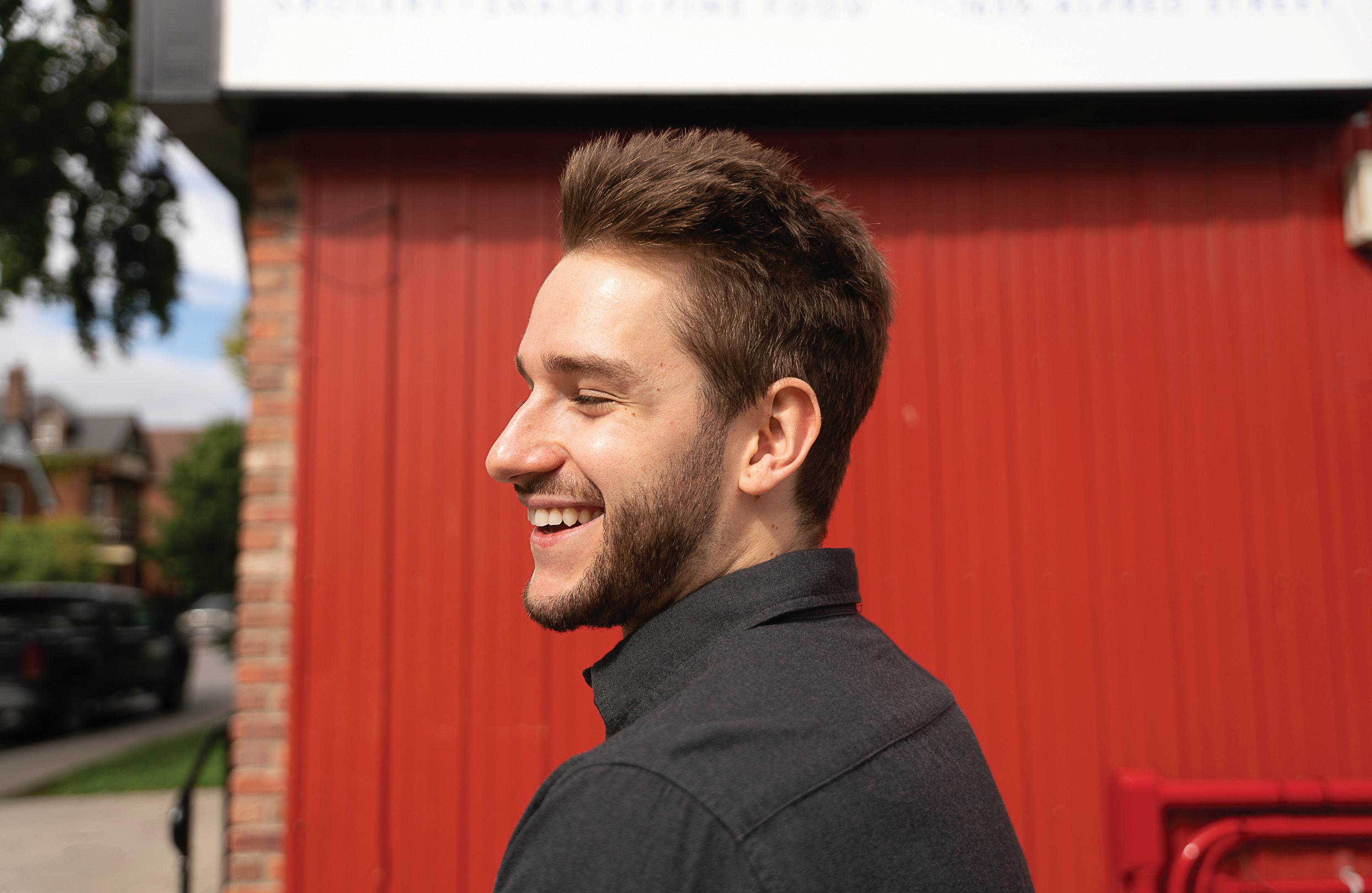
I used to hate the way I looked.
Standing in front of the mirror genuinely made me upset growing up—I never looked anything like my tall, bone-skinny friends. Calling myself ‘fat’ is probably a cruel overstatement, but I was closer to being overweight than I was to being thin.
A lot of people feel this way in grade school and middle school. However, a lot of them also outgrow their baby fat in high school as puberty works its disgusting wonders.
I outgrew mine, to some extent, but I also stopped growing taller. I’ve been five-foot-nine in the right shoes since I was fourteen. While my friends turned into skyscrapers, I was left at the bottom, wondering if I’d ever catch up to them.
I never did.
Still, as high school progressed, I started taking better care of myself and living at a weight that didn’t attract negative attention. I had a good social life, and I’d honed the verbal skills to quickly retaliate against anyone who might make a nasty comment.
start holding myself accountable or give in to the crippling negativity.
I chose to start getting competitive with myself.
***
Over the last few years, the ‘body positivity’ movement has conditioned people to love themselves, no matter how they look. I think that’s great—life’s too short to go through it hating yourself. However, I think if you truly love yourself, you have to push yourself, too.
There are prominent, vocal corners of the media that have taken to demonizing the pursuit of your ideal body or physique. They’ve convinced people that working incredibly hard to look a certain way is immature, toxic, and unhealthy.
I think, deep down, we all know that isn’t true.
If you’re working to be the best physical version of yourself, and you’re making healthy choices to do so, in no way is working hard a negative action.
of the mirror. Personally, in my opinion, what’s much worse is being unhappy with what you see and doing nothing about it.
Devoting yourself to self-improvement, especially as it pertains to fitness, is an exhausting, often downright gruelling endeavour. Sitting at home and lying to yourself about being one hundred per cent happy with the way you look is much, much easier than going to the gym.
This is where self-competition comes in.
You aren’t perfect. The good news is if you’re willing to push yourself, you can look exactly how you want—assuming, of course, you set realistic and attainable expectations.
No matter how hard they train, 99.9 per cent of guys cannot and will not ever look like Dwayne Johnson. However, that’s no reason to let the lazy naysayers stop you from trying.
Let me be clear: getting competitive with yourself is not the same as putting yourself down.
It’s not about over-analyzing your flaws or picking yourself apart. Rather, it’s about identifying areas where you want to grow as a person—be it physically, emotionally, spiritually, etc.—and challenging yourself to make those changes.
missing a workout. It didn’t matter whether I was tired, sad, hungry, or hungover; I was going to the gym to accomplish my goals.
I haven’t skipped a workout in years. Have they all been amazing? Absolutely not—but what matters to me more is not losing any battles to myself. There are few things in life more empowering than sticking to a challenging goal that you’ve set for yourself.
***
Competing with yourself doesn’t have to be about fitness.
Think about your favourite skill. It could be playing an instrument, writing essays, or just being a good friend to those you care about. Ask yourself when you last evaluated your abilities, and when you last set a goal to improve them.
for The Journal, working on a short story for class, or, on a good day, adding a new chapter to my forever-in-progress manuscript.
Doing QJ work is usually the easiest—it’s my job, after all. However, sometimes, even when I’m busy or feeling unmotivated, I challenge myself to write creatively.
Try this out: whatever your ‘thing’ is, force yourself to do it today. You might think this takes away the pleasure of whatever that ‘thing’ is, but I think you’ll quickly feel how rewarding it is to persevere through a lack of motivation. Go do your thing.
If you need perspective, think about yesterday.
Consider that version of yourself and compete with them. Did they do something that brought you closer to your goals? Good, then match them. Beat them, even. If they didn’t, then get back on track and be better than you were yesterday.
It may seem ridiculous to think about being a good friend as a skill, but it involves a series of behaviours you can practice. Attentiveness, active listening, and empathy are all values within friendship that you can improve on. You can challenge yourself to be better at these things every single day.
When I was younger, long before I got a gym membership or knew how to lift weights, I used to force myself to run around the block every day.
When I got to Queen’s, I gained my freshman fifteen. Or twenty.
At the end of that year, I remember seeing myself in the mirror and once again feeling repulsed, no different than when I was a kid. That’s when I knew I had a choice: I could either
Getting six-pack abs is incredibly challenging. Building the perfect butt takes time. The time and effort involved in getting them are why they’re so rewarding. Being lazy is easy; giving in to unhealthy impulses is easier than fighting them.
There’s nothing wrong with wanting abs. There’s nothing wrong with wanting to look amazing when you stand in front
When I started competing with myself, it meant going to the gym five times a week and never
Humbling yourself is key to personal growth. We all have an ego; when you acknowledge how yours may be holding you back, you’ll see how you can get better.
Personally, another area where I like to challenge myself is through writing.
I challenge myself to at least work with words, if not write something every day. Right now, that could mean writing something
At first, I genuinely hated it. Running made my legs hurt, and always made it hard to breathe because of my asthma. However, I never regretted it afterwards. I was always proud of myself for putting down my Xbox controller and being active.
Later, in high school, I fell in love with running for a while and became a sprinter. Challenging yourself is a pathway to growth, self-improvement, and discovery.
Now, when I look in the mirror, I still don’t look exactly how I want after years of working out. The difference now is I’m totally okay with that—I’ll get there eventually.
Ben believes competing with himself is the greatest motivator for growth.
PHOTO BY CURTIS HEINZL
“[...] If you truly love yourself, you have to push yourself, too.
“ There’s nothing wrong with wanting to look amazing when you stand in front of the mirror.
“There are few things in life more empowering than sticking to a challenging goal that you’ve set for yourself.
“ If you need perspective, think about yesterday.
LifestyLe16 • queensjournal ca Friday, 23 september, 2022
